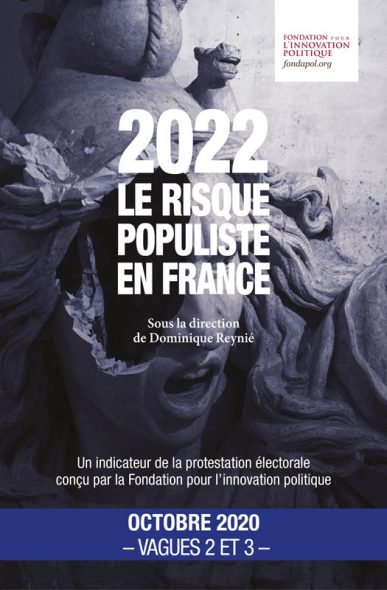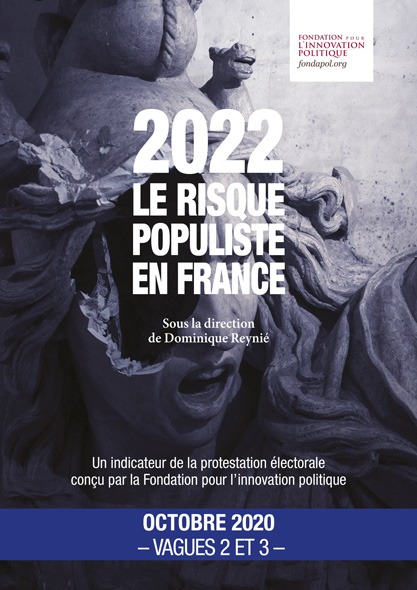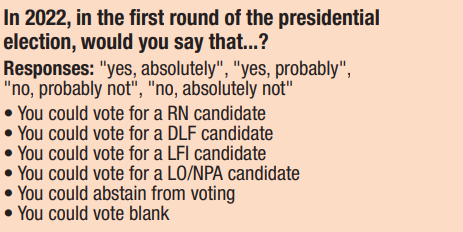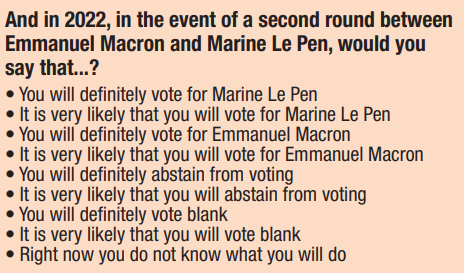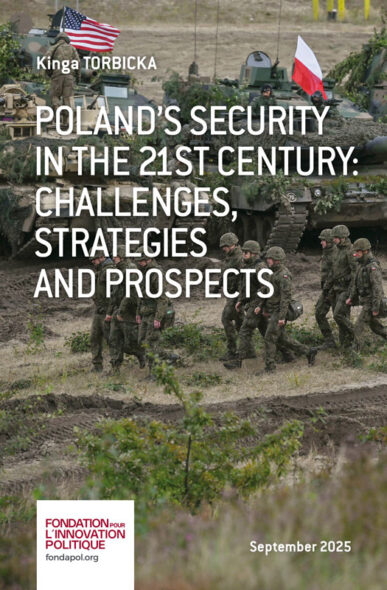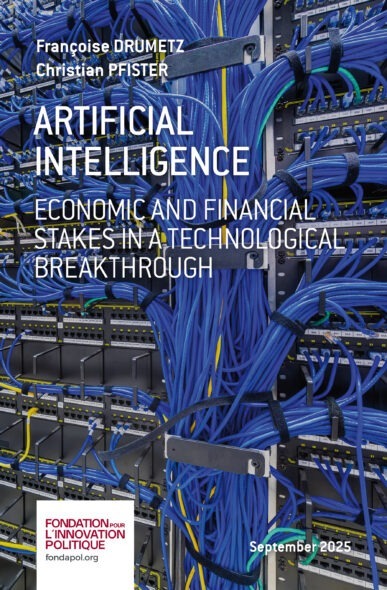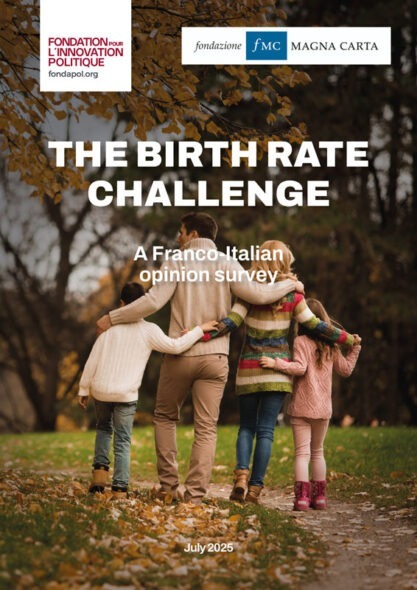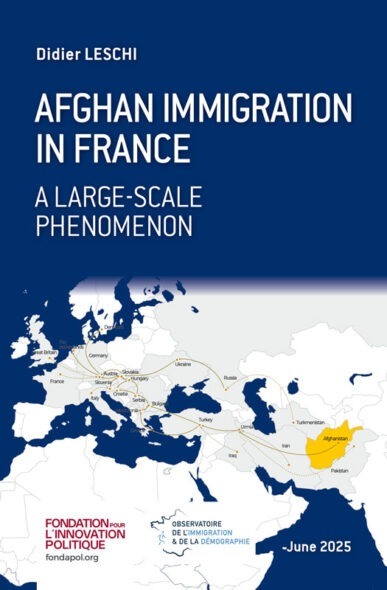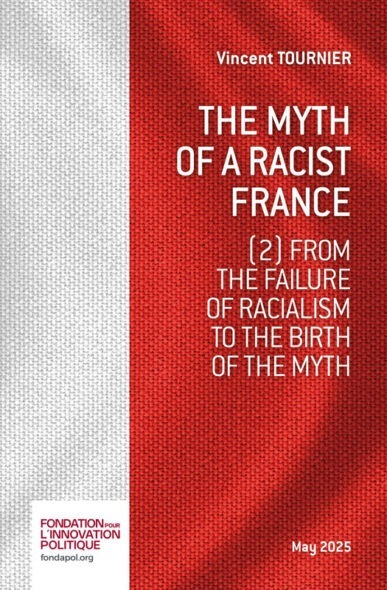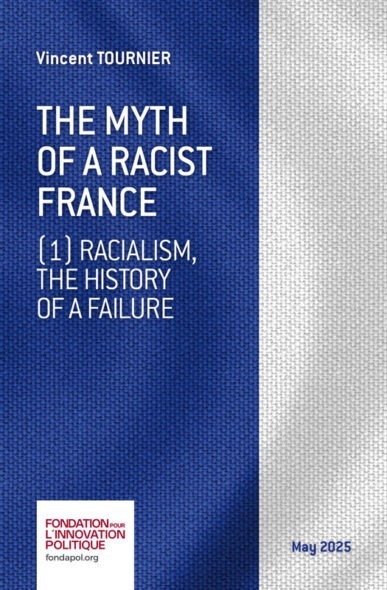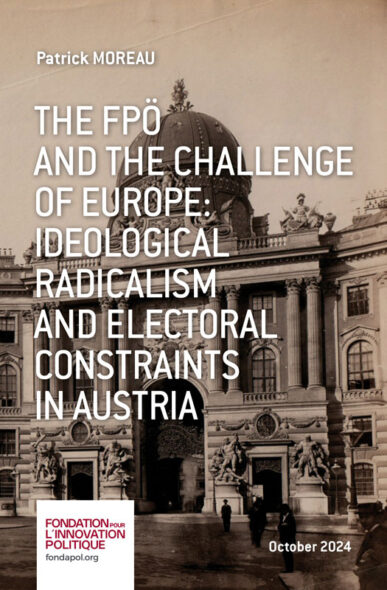2022, the Populist Risk in France - waves 2 and 3
2022, the Populist Risk in France: An indicator of electoral protest in the run-up to the presidential election
The main lessons from waves 2 (January 2020) and 3 (September 2020)
Electoral protest is on the rise.
Introduction
2022, the Populist Risk in France: an indicator of electoral protest designed by the Fondation pour l’innovation politique
Wave 1, wave 2, wave 3: with each wave, a context of crisis (to be continued)
What the notion of electoral protest covers here
Presidential election: the populist temptation remains
Estimating the electoral potential of a protest climate
In September 2020, most voters (79%) still envisage protest behaviour for 2022
Clearly weakened in wave 2, Emmanuel Macron finds a more favourable position in wave 3 in the event of a second round against Marine Le Pen
Opposition to the retirement reform favoured a merging of both left and right-wing populist electorates
The willingness to abstain from voting and voting blank remains a basic trend
For 2022, voters do not reject PS, LREM, LR and, even less so, EELV candidacies
The populist risk falls into the process of democratic deconsolidation
More than a third of the French (37%) question representative democracy
Detachment from representative democracy serves right-wing populism
The idea of a government in which the people would decide for themselves aggregates protesting worlds
The new media, a public space conducive to populism
The resources of electoral protest
Society is perceived as increasingly violent
The choice of a protest vote is asserting itself among voters who have a positive image of the Yellow Vests
The health crisis reinforced a rejection of globalisation
Women and young people seem to offer new reservoirs for electoral protest
The progress of electoral protest does not spare the upper socio-professional category
Fragile resistance to the populist surge
Coronavirus concerns will affect the presidential election
The survey’s questionnaire
DEMOGRAPHIC INFORMATION
Summary
Here are the results of waves 2 and 3 of our electoral protest indicator, launched in September 2019 in view of the upcoming presidential election. Wave 2 of this survey (from 23 to 31 January 2020) took place in the context of a deep social and political crisis mixing the persistence of the Yellow Vests’ protests with demonstrative opposition to the retirement
reform.
The context of wave 3 (from 7 to 11 September 2020) is that of a suspended or postponed conflict, under the effect of the health crisis brought on by the Covid-19 pandemic. This wave 3 is a continuation of the unprecedented collective experience of lockdown, between 17 March and 11 May 2020, followed by new spikes in contamination and the fear of a second wave of the pandemic.
As each crisis wave is added to the previous one, the question arises as to how this unrest, unprecedented in its anomic form and intensity, will express itself in the 2022 presidential election. Our indicator aims to help understand and anticipate the outline of this future presidential election, keeping in mind that the largest political event in France is not without European consequences.
The election protest indicator was developed by the Fondation pour l’innovation politique and the survey was administered by the polling institute OpinionWay. For each wave, the questionnaire is administered to a sample of more than 3,000 people who are registered to vote.
The results of wave 1 led to an initial publication (October 2019) available here. Here are the results of wave 3, with which we are also presenting those of wave 2, as its publication was postponed due to the lockdown. All the results of the survey are freely available on our website data.fondapol.org.
Dominique Reynié,
Director of the Fondation pour l’innovation politique, Professor at Sciences Po, Paris.
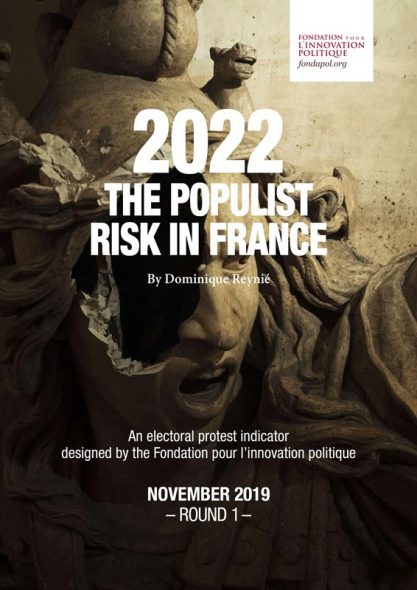
2022 The populist risk in France
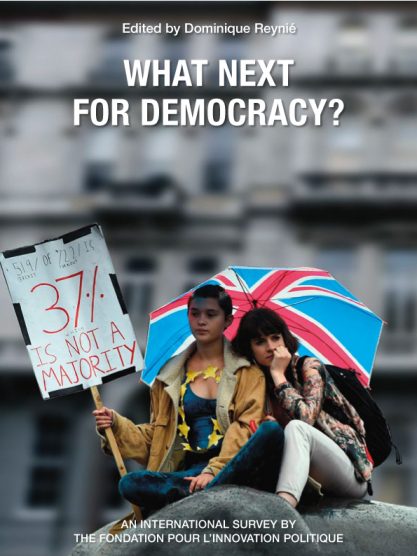
What next for democracy?
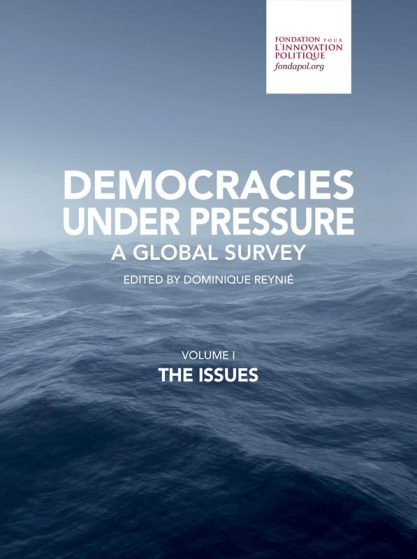
Democracies Under Pressure - A Global Survey - Volume I. The issues
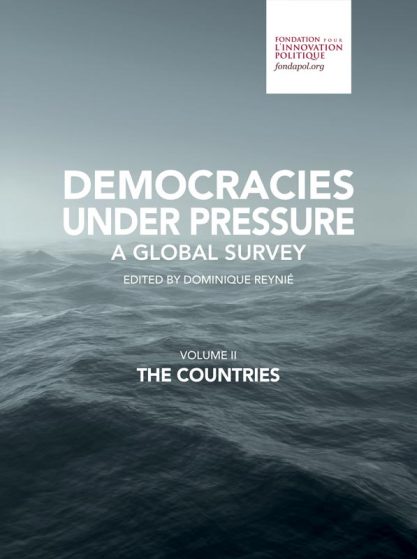
Democracies under pressure - a global survey - volume II. the countries
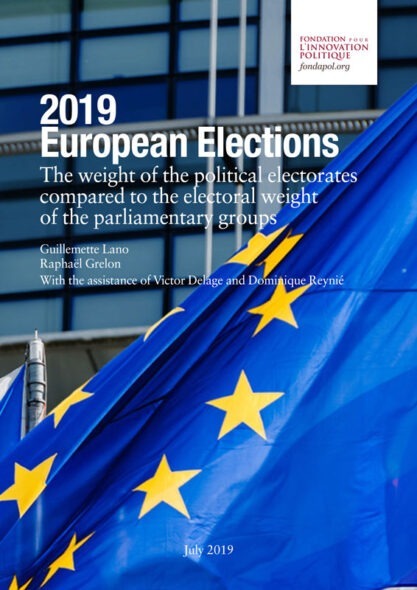
2019 European Elections. The weight of the political electorates compared to the electoral weight of the parliamentary groups
Dominique REYNIÉ, Executive Director of the Fondation pour l’innovation politique
Agathe BAILLEUL, Victor DELAGE, Willy DELVALLE, Madeleine HAMEL, Katherine HAMILTON, Dominique REYNIÉ
Agathe BAILLEUL, Victor DELAGE, Willy DELVALLE, Anne FLAMBERT, Madeleine HAMEL, Katherine HAMILTON, Sasha MORINIÈRE, Mélanie ULLMO
Agathe BAILLEUL, Katherine HAMILTON
Julien RÉMY
the Fondation pour l’innovation politique
the polling institute opinionway
Guillaume INIGO (Project Director),
Bruno JEANBART (Deputy Managing Director),
Clément ROYAUX (Project Manager)
October 2020
Abbreviations of the different political parties used in this study
DLF: Debout la France! [Stand Up, France!] • EELV: Europe Écologie-Les Verts [Europe Ecology – The Greens] • FdG: Front de gauche [Leftist Front] •
LFI: La France insoumise [Unsubjugated France] • FN: Front national [National Front] • LO: Lutte ouvrière [Workers’ Struggle] •
LR: Les Républicains [The Republicans] • LREM: La République en marche • NPA: Nouveau Parti anticapitaliste [New Anti-Capitalist Party] •
PCF: Parti communiste français [French Communist Party] • PS: Parti socialiste [Socialist Party] • RN: Rassemblement national [National Rally]
2022, the Populist Risk in France: An indicator of electoral protest in the run-up to the presidential election
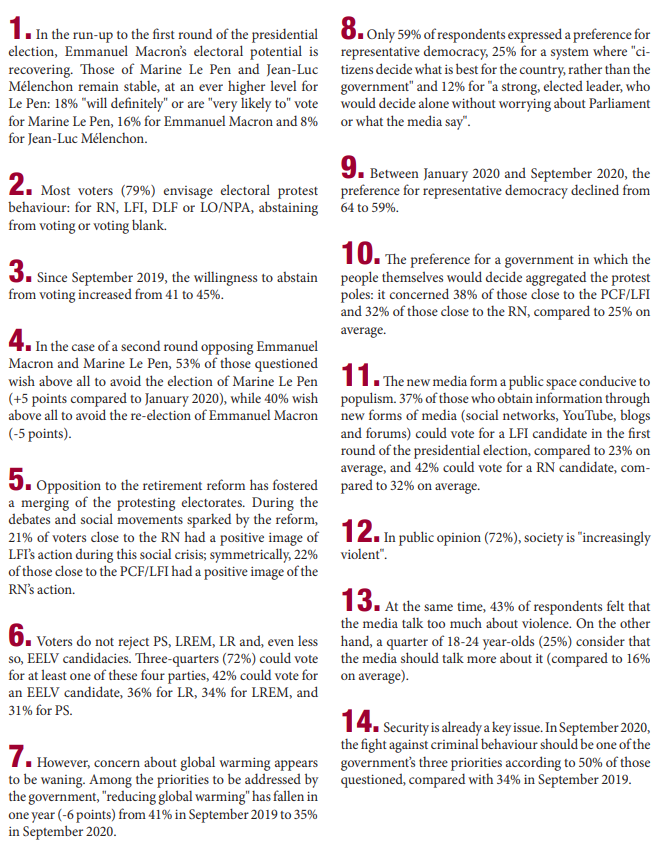
The main lessons from waves 2 (January 2020) and 3 (September 2020)
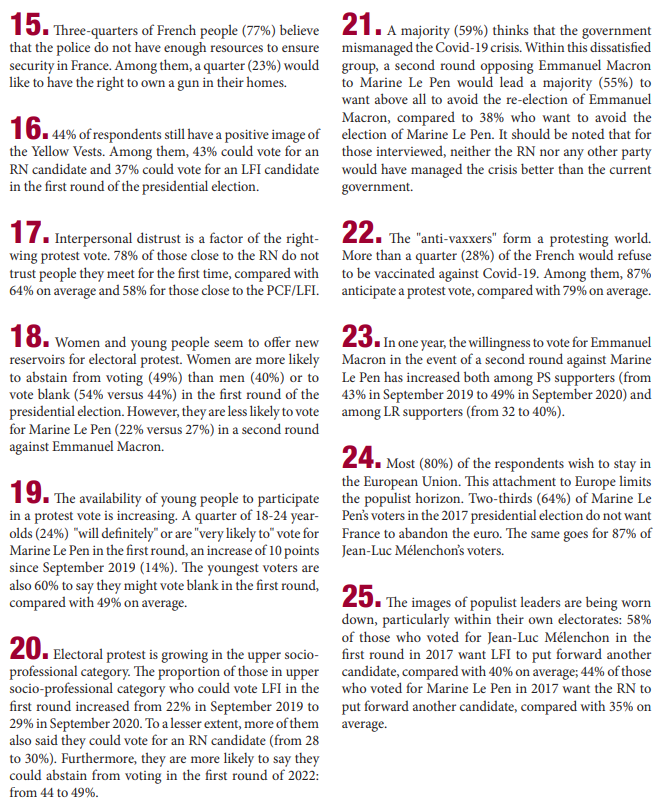
Electoral protest is on the rise.
The first graph depicts populist and anti-establishment votes in the first round of the presidential election. The level varies depending on whether or not the PCF vote is included. We offer two datasets: one including the Communist vote, with the exception of Pierre Juquin’s candidacy in 1988, the other not including it. It should be noted that the results were calculated based on the ballots cast as well as the registered voters, which makes it possible to subsequently integrate abstention and blank (or invalid) votes into the same assessment, offering the possibility of an overall assessment of electoral protest from 1965 to 2017.
The populist vote in the first round of the presidential election (1965-2017) in % of ballots cast
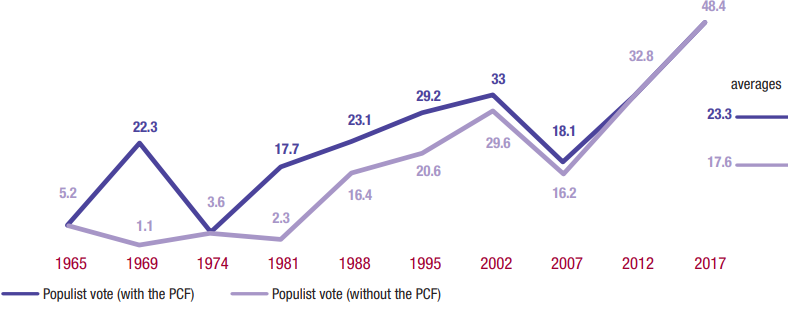
Source :
Compilation of election results by the Fondation pour l’innovation politique (Ministry of the Interior).
The populist vote in the first round of the presidential election (1965-2017) in % of registered voters

Source :
Compilation of election results by the Fondation pour l’innovation politique (Ministry of the Interior).
Selected Candidates: 1965: J.-L. Tixier-Vignancour (Comités Tixier-Vignancour); 1969: J. Duclos (PCF), A. Krivine (LC); 1974: J.-M. Le Pen (FN), B. Renouvin (NAR), A. Laguiller (LO), A. Krivine (FCR); 1981: A. Laguiller (LO), G. Marchais (PCF); 1988: J.-M. Le Pen (FN), A. Laguiller (LO), A. Lajoinie (PCF); 1995: J.-M. Le Pen (FN), A. Laguiller (LO), R. Hue (PCF), J. Cheminade (SP); 2002: B. Mégret (MNR), J.-M. Le Pen (FN), A. Laguiller (LO), O. Besancenot (LCR), R. Hue (PCF), D. Gluckstein (PT); 2007: J.-M. Le Pen (FN), A. Laguiller (LO), O. Besancenot (LCR), M.-G. Buffet (Gauche populaire et antilibérale), G. Schivardi (PT); 2012: Mr Le Pen (FN), N. Dupont-Aignan (DLR), J.-L. Mélenchon (FdG), P. Poutou (NPA), N. Arthaud (LO), J. Cheminade (SP); 2017: Mr Le Pen (FN), N. Dupont-Aignan (DLF), F. Asselineau (UPR), J.-L. Mélenchon (FI), P. Poutou (NPA), N. Arthaud (LO), J. Cheminade (SP).
2022, the Populist Risk in France: an indicator of electoral protest designed by the Fondation pour l’innovation politique
2022, the Populist Risk in France is an indicator of electoral protest, designed by the Fondation pour l’innovation politique. The questionnaires are written by the Foundation’s team and the surveys conducted by the polling institute OpinionWay.
To ensure the soundness and interest of the data collected, the questionnaire is each time administered to a sample of 3,000 people registered on the electoral rolls and drawn from a sample of 3,423 people representative of the French population aged 18 and over. The representativeness of the sample is ensured by the quota method, with regard to criteria of gender, age, socio-professional category, category of urban area and region of residence. We carry out one measurement every six months.

Wave 1 was administered from 30 August to 6 September 2019 to 3,006 people. The presentation and analysis of the results resulted in a publication entitled 2022, le risque populiste en France (2022, the Populist Risk in France), available in French and English on the fondapol.org website.
Wave 2 was administered from 23 to 31 January 2020 to 3,055 people. The social and political context was tense at the time, particularly because of the retirement reform. We had therefore added certain contextual questions about the understanding and acceptance of this reform. However, in the weeks that followed, the coronavirus epidemic led us to postpone the publication of the second volume. We have chosen to integrate the main results from the second wave in this edition, together with the results of wave 3.
Wave 3 was administered from 7 to 11 September 2020 to 3,037 people, i.e. after the period of lockdown (17 March-11 May 2020) and at the end of a summer when certain restrictions were lifted. The cycle of opinion in this third wave includes a rise in the number of coronavirus cases in France as well as fears of a second wave of the epidemic. This volume therefore presents the results of the second and third waves. The text and the questionnaire are available in French and English on the fondapol.org website and the complete data are shared on data.fondapol.org.

Wave 1, wave 2, wave 3: with each wave, a context of crisis (to be continued)
The first wave of our barometer (September 2019) was dominated by the Yellow Vests movement, both broad and deep, carrying an unprecedented radicalism. The second wave (January 2020) took place in a context that did not see the destabilising effect of the Yellow Vests dissipate, but in which an opposition to the retirement reform was mixed in and partly reinforced. The third wave then (September 2020) took place in a context where the conflict generated by the two previous crises seemed momentarily suspended or postponed because of the historic health crisis we are experiencing. In fact, during our first three waves, each crisis cycle was added to the previous one, rather than taking its place. Perhaps this is due to the strange nature of this year covered by our three studies, from September 2019 to September 2020.
What the notion of electoral protest covers here
See Dominique Reynié, Les Nouveaux Populismes, Pluriel, 2013.
See “Loi du 21 février 2014 visant à reconnaître le vote blanc aux élections“, vie-publique.fr, 24 February 2014.
The question arises as to how these crises, which are superimposed one on top of the other, how this incessant agitation, so disruptive in its dispersed, anomic character, in the intensity of which it has proved capable, will be expressed through the mechanisms of the 2022 presidential election. Our indicator aims to help understand and anticipate the contours of this future presidential election, with potentially European and therefore global consequences.
The Electoral Protest Indicator estimates the potential of different possible electoral protest behaviours: abstention from voting, voting blank, voting for populist parties or candidates. In our indicator, the idea of a protest electorate covers three types of electoral behaviour:
- Voting, or a willingness to vote, for populist parties and candidates (Marine Le Pen, RN, Jean-Luc Mélenchon, LFI and Nicolas Dupont-Aignan and the DLF);
- Voting, or a willingness to vote, for parties and candidates on the revolutionary left (LO and NPA).
- Abstention from voting and blank votes.
a) The populist vote
Populist voting includes votes, here meaning the willingness to vote for a populist party. We characterise populist parties using the following elements1:
- An appeal to the This is the heart of populist discourse, which is a fundamental feature of democratic politics. It is reflected in a rejection of representative democracy and an elevation of direct democracy. The populists’ appeal to the people is characterised by demands for the absolute sovereignty of electoral decisions, which are supposed to prevail over everyone and everything, including the principles and rules that form the bases of order and the rule of law. This is the fundamental difference between liberal democracy and populism, which sometimes calls itself “illiberal democracy.”
- An anti-elite discourse, based on a summary social differentiation between a “people”, unified and mythologised, and political, economic, intellectual, and media “elites”, disqualified as forming an oligarchy (“La Caste”, ).
- A narrative and an organisation marked by an authoritarian culture, found in a form of party built around an omnipresent leader.
- A nationalist programme.
- A xenophobic vision.
- A rhetorical style notably characterised by exaggeration, simplification, disqualification of the opponent, a tendency to conspiracy explanations, etc.
Starting with the 4th criterion, we see a separation between two expressions of populism: the largely dominant expression that has met with major electoral successes deploys nationalism through xenophobia, denouncing not only the ruination of the people by the elites, but also by foreign people, immigrants. Xenophobic populism is most often right-wing, even if it exists on the left in Europe. In France, left-wing populism is represented by Jean-Luc Mélenchon and his party La France insoumise. He does not want to or cannot make a lasting commitment to xenophobia, despite a few steps in that direction. He has paid the electoral price as he is outpaced by the right- wing populism of Marine Le Pen and the RN.
Lastly, wenotearhetorical style characterised in particular by exaggeration, simplification, disqualification of the adversary, a tendency to conspiracy theories, etc.
As the case of Nicolas Dupont-Aignan and his DLF party is uncertain, sitting as it does between the sovereigntist right and the populist right, we have made the choice to take it into account in the calculation of the populist electoral potential. In 2017, during the two-rounds of the presidential election, the president of Debout la France had made an agreement with Marine Le Pen’s government after which he would have become her prime minister in case of the election of the candidate of the Front national.
Fundamentally, it is important to distinguish between populist parties and parties from the revolutionary left. In fact, some parties put forth an anti-establishment vision without the codes of populism, instead speaking in terms of internationalism and social classes. They claim to speak for the working class, possibly extended to include all “working people,” but not “the people” writ large. Indeed, they do not recognise themselves in the principles and mechanisms of electoral democracy that populists, on the contrary, claim they wish to implement. In France, these are the far-left Trotskyite parties. However, here, without dismissing these differences, we chose to integrate the far-left vote into the calculation of the populist electoral potential so as not to unnecessarily increase the complexity of the indicator, bearing in mind, on the one hand, that the electoral weight of this anti-establishment left is marginal, with two exceptions in 2002 (10.4% of the votes cast and 7.2 percent of registered voters) and in 2007 (5.8 percent of the vote cast and 4.8 percent of registered voters), and, on the other hand, that the respondents who recognise themselves in the parties of this anti-establishment left and who vote for their candidates testify in our study to a great willingness to vote for populist parties, no doubt animated by their anti-systemic strategy.
b) Abstention
There are varied forms of abstention. Notably, abstention may be systematic or intermittent. The reasons for abstention are diverse: expression of disinterest, inability to choose, expression of a rejection of the political choices or even more general discontent. Since only some abstentions are a form of electoral protest, it is difficult to assess this from electoral results. However, here we choose to include abstention in the calculation of the potential for electoral protest because we are asking people about their willingness to abstain from voting in 2022. We will also note the similarity between the abstention curve and that of the protest vote.
c) The blank vote
Until 2014, the census of blank votes was combined with invalid votes (null votes). The category was called “blanks and invalid”. Blank votes have been counted separately since the law of 21 February 20142. They were listed separately for the first time in the European elections in June 2014. The 2017 presidential election was the first where the new blank vote system was applied. Here, we choose to include blank voting in the calculation of the potential for electoral protest because we are asking people about their willingness to vote blank in 2022.
Vote for revolutionary left-wing parties (excluding the PCF) in the first round of the presidential election (1965-2017)

Source :
Compilation of election results by the Fondation pour l’innovation politique (Ministry of the Interior).
Abstentions during the first round of the presidential election (1965-2017) in % of registered voters

Source :
Compilation of election results by the Fondation pour l’innovation politique (Ministry of the Interior).
Blank and invalid votes in the first round of the presidential election (1965-2017) in % of registered voters

Source :
Compilation of election results by the Fondation pour l’innovation politique (Ministry of the Interior).
* Since the law on 21 February 2014, the census of blank votes has no longer been combined with invalid votes (null votes). The 2017 presidential election was the first where the new blank vote system was applied.
Electoral protest in the first round of the presidential election (1965-2017) (the populist vote, blank and invalid votes and abstention) in % of registered voters
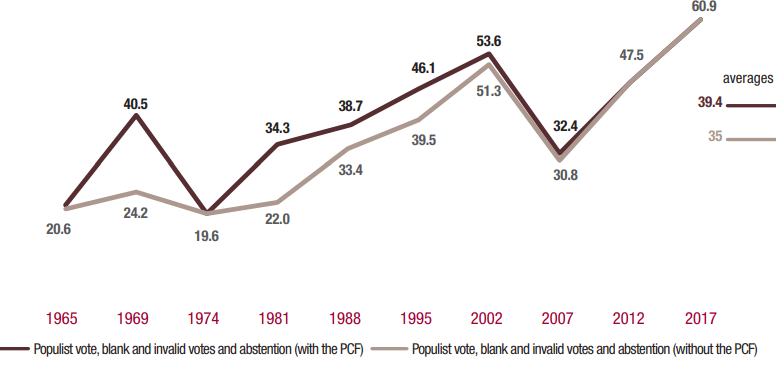
Source :
Compilation of election results by the Fondation pour l’innovation politique (Ministry of the Interior).
Selected Candidates: 1965: J.-L. Tixier-Vignancour (Comités Tixier-Vignancour); 1969: J. Duclos (PCF), A. Krivine (LC); 1974: J.-M. Le Pen (FN), B. Renouvin (NAR), A. Laguiller (LO), A. Krivine (FCR); 1981: A. Laguiller (LO), G. Marchais (PCF); 1988: J.-M. Le Pen (FN), A. Laguiller (LO), A. Lajoinie (PCF); 1995: J.-M. Le Pen (FN), A. Laguiller (LO), R. Hue (PCF), J. Cheminade (SP); 2002: B. Mégret (MNR), J.-M. Le Pen (FN), A. Laguiller (LO), O. Besancenot (LCR), R. Hue (PCF), D. Gluckstein (PT); 2007: J.-M. Le Pen (FN), A. Laguiller (LO), O. Besancenot (LCR), M.-G. Buffet (Gauche populaire et antilibérale), G. Schivardi (PT); 2012: M. Le Pen (FN), N. Dupont-Aignan (DLR), J.-L. Mélenchon (FdG), P. Poutou (NPA), N. Arthaud (LO), J. Cheminade (SP); 2017: M. Le Pen (FN), N. Dupont-Aignan (DLF), F. Asselineau (UPR), J.-L. Mélenchon (FI), P. Poutou (NPA), N. Arthaud (LO), J. Cheminade (SP).
Presidential election: the populist temptation remains
Estimating the electoral potential of a protest climate
For the upcoming first round of the 2022 presidential election, the electoral potential of the parties and candidates is estimated based on the following question:
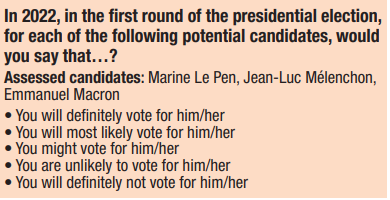
The responses provided allow us to define electoral potential on a three-point scale:
- minimum electoral potential, which reflects the proportion of respondents having responded “you will definitely vote for him/her”;
- intermediate electoral potential, which reflects the proportion of respondents having chosen “you will definitely vote for him/her” or “you will most likely vote for him/her”;
- maximum electoral potential, which reflects the proportion of respondents having chosen “you will definitely vote for him/her”, “you will most likely vote for him/her” or “you might vote for him/her”.
We must distinguish here between the electoral potential of a party or a candidate, which is the willingness declared by the interviewees to vote for this party or candidate, and the potential for electoral protest, which refers to the willingness declared by the interviewees to adopt electoral protest behaviour (abstention from voting, voting blank, or voting in favour of populist or anti-establishment parties or candidates).
As such, our indicator defines the electoral potential of populist candidates and compares them with the electoral potential of Emmanuel Macron.
Wave 2 of our indicator (January 2020) recorded the effects of the crisis generated by opposition to the retirement reform. We notably observed variation in Emmanuel Macron’s electoral potential for the first round of the presidential election. Wave 3 (September 2020), conducted in the context of the health crisis, shows a significant recovery.
Memo for the reader: in September 2019, regarding Marine Le Pen’s candidacy, 9% of respondents replied that they “will definitely” vote for her; 17% replied that they “will definitely” or “will most likely” vote for her; 31% replied that they “will definitely”, “will most likely” or “might” vote for her.
The electoral potential of Emmanuel Macron is recovering. Those of Marine Le Pen and Jean-Luc Mélenchon remain stable, at a higher level for Le Pen

© Fondation pour l’innovation politique – October 2020
The hotbeds of electoral protest potential
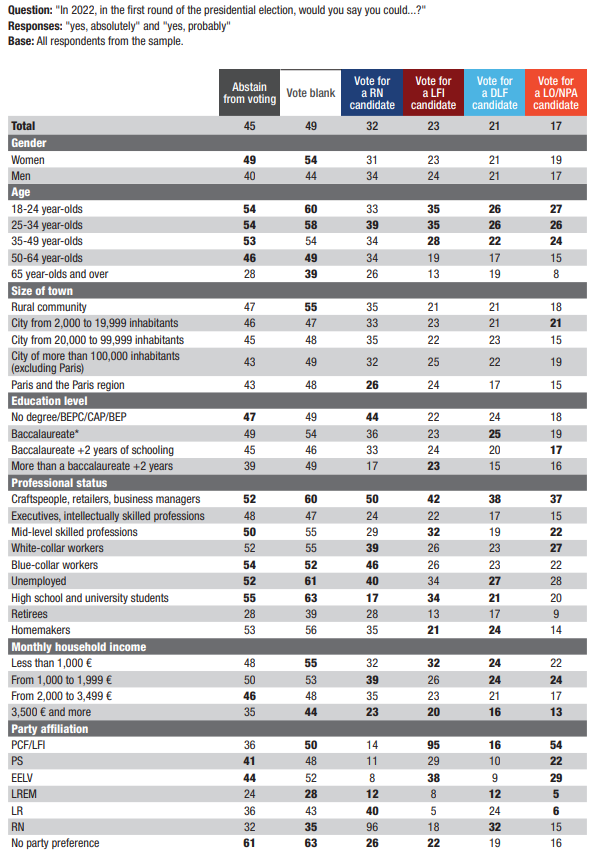
Copyright :
© Fondation pour l’innovation politique – October 2020
The hotbeds of electoral protest potential (continued)
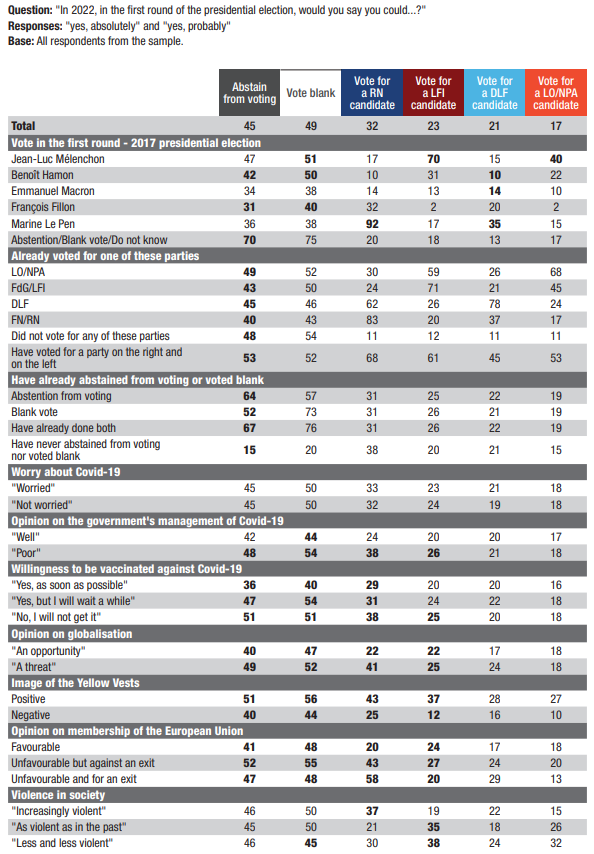
Copyright :
© Fondation pour l’innovation politique – October 2020
In September 2020, most voters (79%) still envisage protest behaviour for 2022
The third wave of our indicator shows that most respondents (79%) say they are willing to opt for one of the tested behaviours relevant to electoral protest, i.e. voting for RN, LFI, DLF or LO/NPA, abstaining from voting or voting blank. The electoral protest potential strictly speaking concerns 51% of voters who say they are willing to vote for at least one of the RN, LFI, DLF or LO/NPA candidates. Furthermore, a large majority of respondents (59%) said they could abstain from voting or vote blank in the first round of the 2022 presidential election.
September 2019-September 2020: evolution of the electoral protest potential for the first round of the 2022 presidential election

As we observed in September 2019, the attraction capacity of right-wing populism is much greater than that of left-wing populism. In September 2020, 38% of voters plan to vote for the RN or DLF, compared to 27% for LFI or LO/NPA.
The surge of the populist vote accompanies its right- wing nature. In addition, 46% of respondents could vote for at least one of the two major populist parties, the RN and LFI.
Since September 2019, the willingness to vote for populist parties has been on the rise
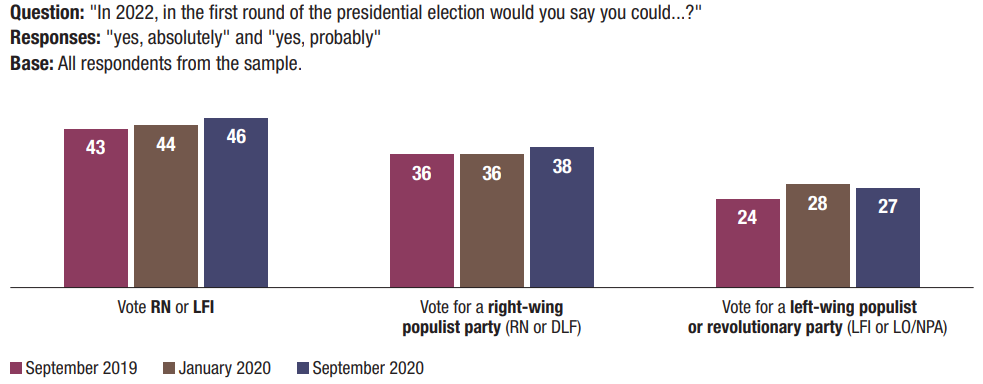
Copyright :
© Fondation pour l’innovation politique – October 2020
Clearly weakened in wave 2, Emmanuel Macron finds a more favourable position in wave 3 in the event of a second round against Marine Le Pen
Between wave 1 (September 2019) and wave 2 (January 2020), the willingness to vote for Marine Le Pen increased by 4 points (from 23 to 27%). Conversely, the willingness to vote for Emmanuel Macron decreased by 3 points (from 30 to 27%). The two candidates were therefore on a level playing field. Wave 3 (September 2020) is marked by a clear recovery in the readiness to vote for the current President in this configuration. The gap again becomes favourable to Emmanuel Macron since 6 points separate him from Marine Le Pen (31% versus 25%).
Anticipated changes in electoral behaviour during the second round of the 2022 presidential election (September 2019-September 2020)
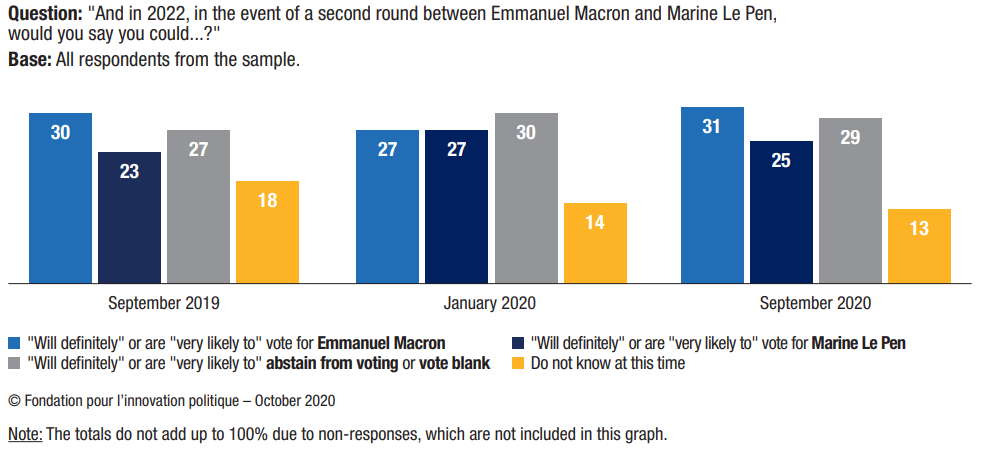
In addition to the gap between the electoral potential of Emmanuel Macron and that of Marine Le Pen, which widens between January and September 2020, at the same time, the desire to above all else avoid the election of Marine Le Pen to the presidency is progressing significantly.
This was one of the particularly striking facts of wave 2 (January 2020): the proportion of those questioned who said they wanted to avoid Marine Le Pen’s election as President became a minority (48%). On the other hand, an approaching proportion (45%) said they wanted to avoid the re-election of Emmanuel Macron. Wave 3 (September 2020) saw the desire to prevent the leader of the RN from acceding to the Elysée Palace increase by 5 points and become a majority (53%), while the proportion of respondents saying they wanted to avoid Emmanuel Macron’s re-election fell by the same amount, to 40%.
What would be more important: avoiding the re-election of Emmanuel Macron or the election of Marine Le Pen?
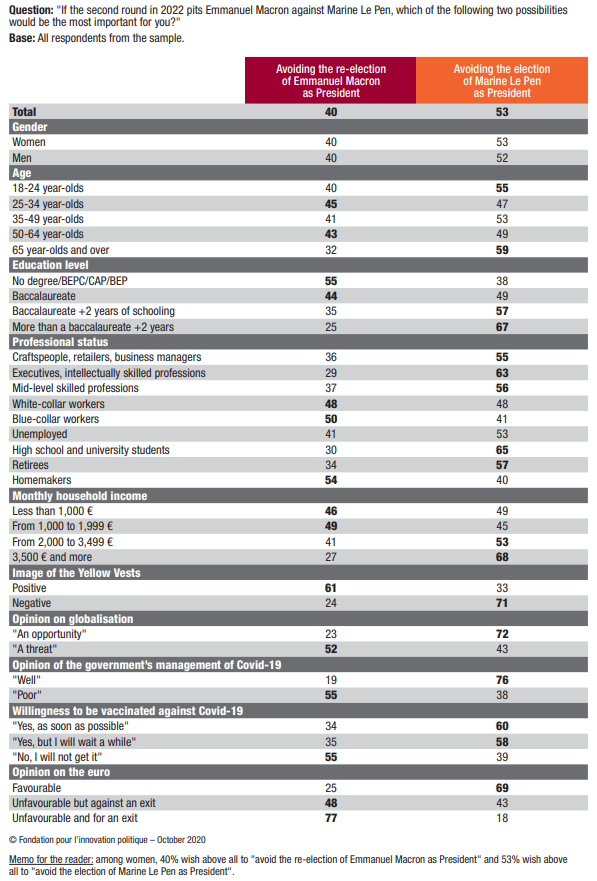
Opposition to the retirement reform favoured a merging of both left and right-wing populist electorates
The political and social climate at the beginning of 2020 remained marked by the Yellow Vests movement. However, the context was further aggravated by the contestation of the retirement reform. Wave 2 of our barometer (January 2020) reveals a high potential for electoral protest among respondents who do not approve of the reform: 89% of them said they could abstain from voting, vote blank, vote populist or vote for the extreme left in the first round of the 2022 presidential election. Opposition to the retirement reform thus pushes a further proportion of the electorate into protest, particularly on the left: 35% of those opposed to the reform said they could vote for a LFI candidate, compared with 24% on average, and 26% said they could vote for an LO/NPA candidate, compared with 19% on average.
Memo for the reader: among the respondents who said in January 2020 that they approved of the retirement reform, 31% said they could abstain from voting in the first round of the 2022 presidential election, 44% could vote blank, 27% could vote for a RN candidate, 13% could vote for LFI, 20% could vote for DLF and 11% could vote for LO/NPA.
There was a strong pull to a protest vote among opponents of the retirement reform (January 2020)

© Fondation pour l’innovation politique – October 2020
To the question “Which of the following political parties do you feel closest to, or least distant from?”, Le parti communiste français (PCF) and La France insoumise (LFI) have been combined into one response option (PCF/LFI). For the other questions, only LFI is concerned.
In this context of social contestation, our indicator highlights a process of merging populist left- and right-wing electorates. In January 2020, voters close to parties on the extremes of the political spectrum rejected this reform: 90% of PCF/LFI3 sympathisers and two-thirds (65%) of voters close to the RN said they were opposed to it. Most PCF/LFI (91%) and RN (82%) supporters said they understood the strikers’ discontent.

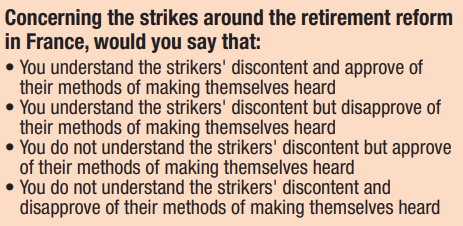
Support for the methods of opponents of the reform was broadest among PCF/LFI respondents (74%) but also concerned almost half of RN supporters (48%). These figures are well above average: almost three- quarters (74%) of French respondents understood the dissatisfaction, but only one-third (32%) approved of the methods they used.
Opposition to the retirement reform has made the protesting electorates more porous. Thus, one in five voters close to the RN (21%) had a positive image of LFI’s attitude during the social movements prompted by the reform. A comparable proportion (22%) of those who said they were close to the PCF/LFI had a positive image of the RN’s action during these demonstrations. Wave 3 (September 2020) shows the persistence of a porosity between right-wing and left-wing populism, despite the suspension of the retirement reform. Thus, 17% of Jean-Luc Mélenchon’s voters in the 2017 presidential election say they are ready to vote for a RN candidate in the first round in 2022. The same is true (17%) for Marine Le Pen’s voters in 2017, who respond that they could vote for a LFI candidate. Lastly, 13% of those who voted for Jean- Luc Mélenchon in 2017 say they “will definitely” or are “very likely to” vote for Marine Le Pen in the event of a second round against Emmanuel Macron in 2022.
The willingness to abstain from voting and voting blank remains a basic trend
See Dominique Reynié (dir.), “Tsunami dans un verre d’eau, Regard sur le vote Europe Écologie-Les Verts aux élections municipales de 2014 et de 2020 dans 41 villes de plus de 100 000 habitants“, Fondation pour l’innovation politique, July 2020.
Abstention did not spare the presidential election, as we saw in 2017, where it reached historic levels in the first round (22.23%) and even more so in the second (25.44%), although it did oppose Emmanuel Macron to Marine Le Pen. The same was true for the blank vote, which reached a very high level in the second round (8.52% of voters).
The municipal elections of 2020 took place in unprecedented circumstances largely brought on by the epidemic crisis. A historic abstention rate was recorded in these elections, in both the first (55.34%) and second rounds (58.40%)4. Although these elections are reputed to be the type of ballot – along with the presidential election5 – for which the French are most mobilised, these municipal elections had an abstention rate in the second round that was 8.5 points higher than that of the 2019 European elections (49.88%), which are generally of less interest to the French.
While the exceptional conditions surrounding this election and the fear of contracting the coronavirus played a role in this massive abstention, our indicator shows a fundamental phenomenon: almost half (45%) of the voters questioned in our survey responded that they could abstain from voting in the first round in 2022, i.e. that they “will definitely” (15%) or are “very likely to” (30%). This is a significant increase if we consider the level recorded in January 2020 (40%) and September 2019 (41%). Half of the voters (49%) say they would be willing to cast a blank ballot, confirming the level recorded (48%) in September 2019.
From September 2019 to September 2020, the willingness to abstain from voting increased
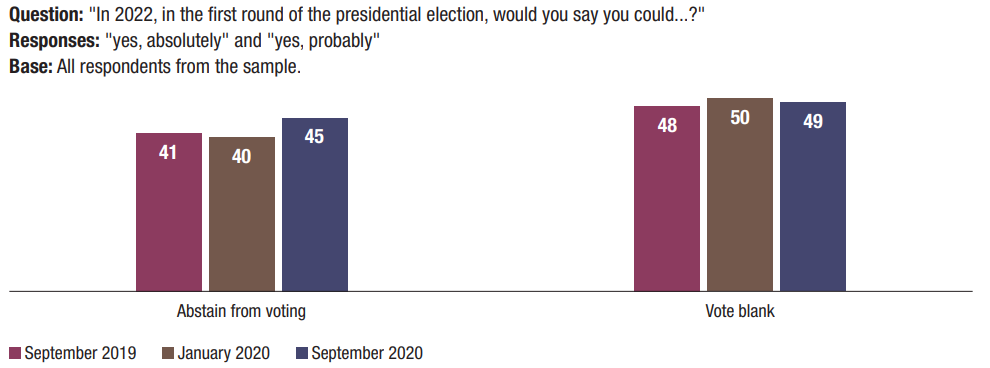
Copyright :
© Fondation pour l’innovation politique – October 2020
The high readiness to abstain from voting declared in September 2020 for the 2022 presidential election partly reflects a difficulty in anticipating future electoral behaviour today, but it is also the expression of a lack of interest in politics. This disinterest can be temporary or lasting. In this case, it may announce a withdrawal from electoral life motivated by disappointment or discontent.
For 2022, voters do not reject PS, LREM, LR and, even less so, EELV candidacies
In wave 3 (September 2020), we tested the willingness of voters to vote in the first round of the next presidential election for the following parties: PS, EELV, LREM and LR. However, at this stage, we were unable to indicate the names of candidates due to the degree of uncertainty and the range of possibilities.
Almost three-quarters of respondents (72%) said they could vote for at least one of these four parties. In detail, more than one-third (34%) of citizens say they could vote for an LREM candidate. This is 3 points more than for a PS candidate (31%), 2 points less than for an LR candidate (36%), and 8 points less than for an EELV candidate (42%).
The potential behaviour of the 2017 electorate by Emmanuel Macron, Marine Le Pen and Jean-Luc Mélenchon
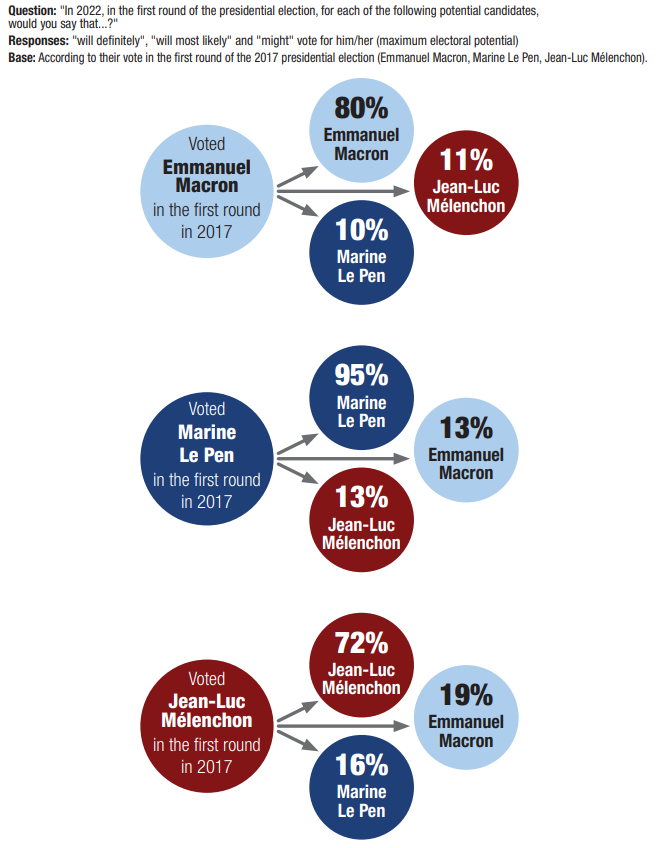
Copyright :
© Fondation pour l’innovation politique – October 2020
Memo for the reader: among the respondents who voted for Emmanuel Macron in first round of the 2017 presidential election, 80% said they “will definitely”, “will most likely” or “might” vote for him in the first round in 2022, 11% plan to vote for Jean-Luc Mélenchon and 10% for Marine Le Pen.
Note: The totals do not add up to 100% as respondents were asked to comment on each candidate and not to choose from them.
The potential behaviour of 2017 electorates in 2022
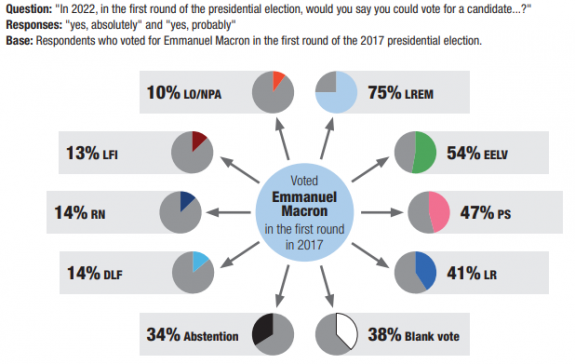
© Fondation pour l’innovation politique – October 2020
Memo for the reader: among the respondents who voted for Emmanuel Macron in the first round of the 2017 presidential election, 75% said they could a LREM candidate, 54% could vote EELV, 47% could vote PS, 41% could vote LR, 38% could vote LR, 38% could vote blank, 34% could abstain from voting, 14% could vote DLF, 14% could vote RN, 13% could vote LFI and 10% could vote LO/NPA.
Note: The totals do not add up to 100% as respondents were asked to comment on each candidate and not to choose from them.
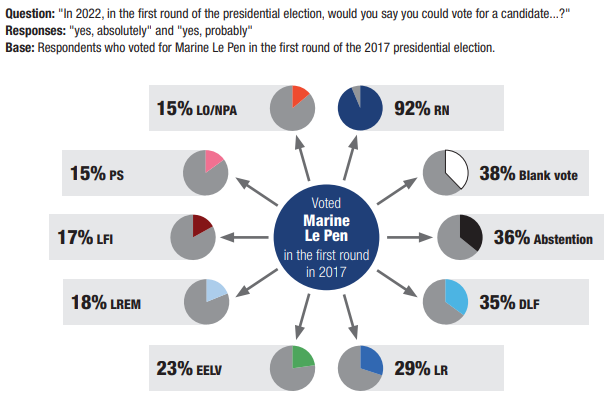
Copyright :
© Fondation pour l’innovation politique – October 2020
Note: The totals do not add up to 100% as respondents were asked to comment on each candidate and not to choose from them.
The potential behaviour of 2017 electorates in 2022 (continued)
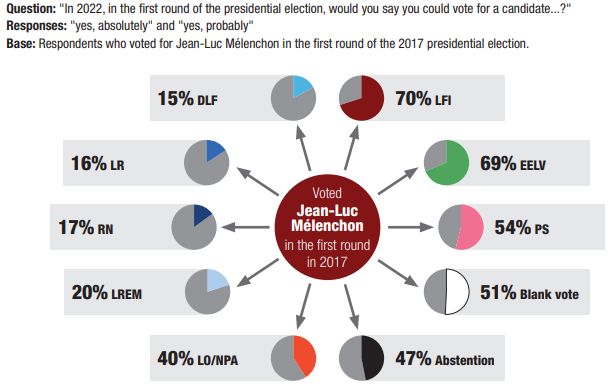
Copyright :
© Fondation pour l’innovation politique – October 2020
Note: The totals do not add up to 100% as respondents were asked to comment on each candidate and not to choose from them.
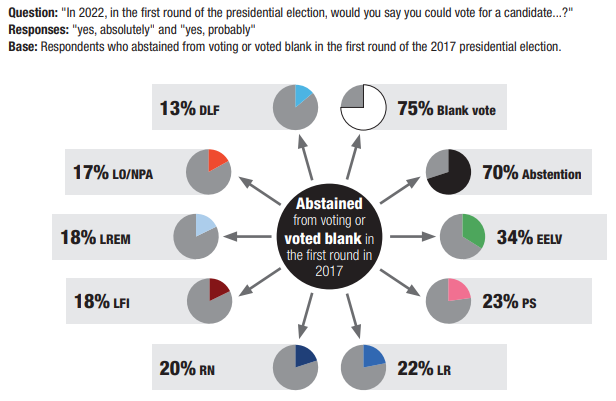
Copyright :
© Fondation pour l’innovation politique – October 2020
Note: The totals do not add up to 100% as respondents were asked to comment on each candidate and not to choose from them.
The potential behaviour of 2017 electorates in 2022 (continued)

Copyright :
© Fondation pour l’innovation politique – October 2020
Note: The totals do not add up to 100% as respondents were asked to comment on each candidate and not to choose from them.
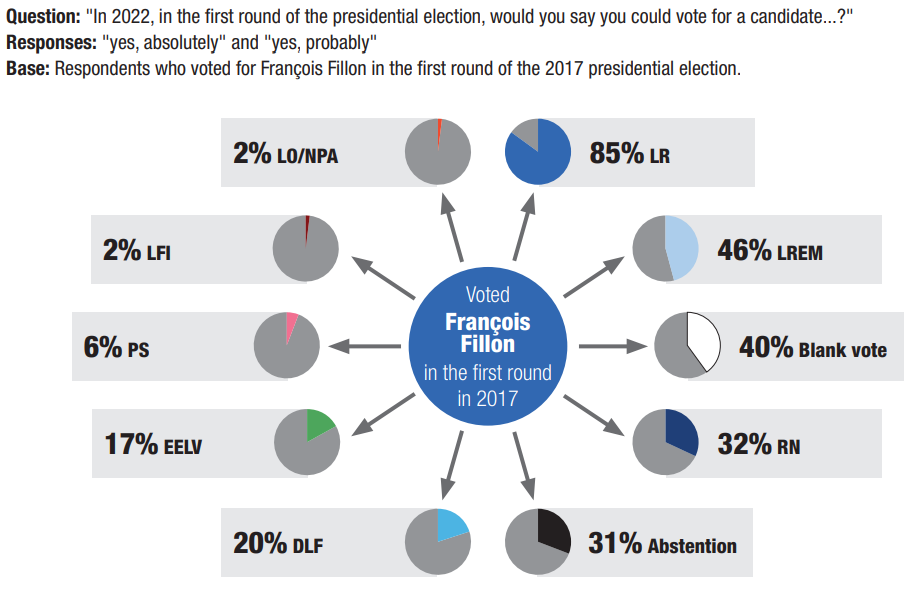
Copyright :
© Fondation pour l’innovation politique – October 2020
Note: The totals do not add up to 100% as respondents were asked to comment on each candidate and not to choose from them.
For the question “Which of the following issues should the government address first? Second? Third?”, respondents were asked to rank (first, second or third) three of the seven proposed options. In analysing the results, we have used the “total” here, which represents the percentage of respondents who mentioned one of these options, either first, second or third, within the list of seven options.
The availability to vote EELV is high compared to its competitors
As noted above, the appeal of an EELV candidacy stands out: 42% of voters would be willing to vote for a candidate of that party. This is more than for any other party tested in our indicator. The readiness to vote Green also stands out in terms of the diversity of profiles among its potential voters. More women (43%) than men (39%) say they could vote for an EELV candidate. Half (52%) of under 35 year-olds say they could vote for an EELV candidate, but this also concerns a large proportion of the 35-49 year-olds (46%) and the 50-64 year-olds (42%). Those aged 65 and over are the most reluctant to the Green vote (27%).
Variations also exist according to socio-professional categories, even if the results are still very high compared to the other assessed parties: blue-collar workers (38%), craftspeople, retailers, business managers (43%), white-collar workers (48%), executives or those with intellectually skilled professions (51%) and those with mid-level skilled professions (52%) are numerous in saying that they could vote Green in 2022. Interestingly, and reflecting the diversity of opinion within this electoral potential: 44% of respondents who have a positive image of the Yellow Vests and 40% of those who have a negative image of the Yellow Vests said they might vote for a Green candidate.
Furthermore, our data show the existence of electoral reservoirs favourable to a Green vote in 2022. Three- quarters of Benoît Hamon’s voters (74%) in the 2017 presidential election say they are ready to vote for an EELV candidate in the first round in 2022. The same is true for 69% of Jean-Luc Mélenchon’s voters and 54% of Emmanuel Macron’s voters in 2017. It should be noted that nearly a quarter of Marine Le Pen voters in 2017 (23%) also responded that they could vote for an EELV candidate.
Nevertheless, the fight against climate change seems to have been relegated to the background. To the question “Which of the following issues should the government address first? Second? Third?”6, the answer “reducing global warming” shows a sharp drop in one year across the board (-6 points), from 41% in September 2019 to 35% in September 2020, finding itself in 5th position in the priorities that the government should address, behind unemployment (54%), criminal behaviour (50%), social inequalities (41%) and immigration (37%).
The certainty of voting for EELV in 2022 is more affirmed than for the PS, LR and LREM
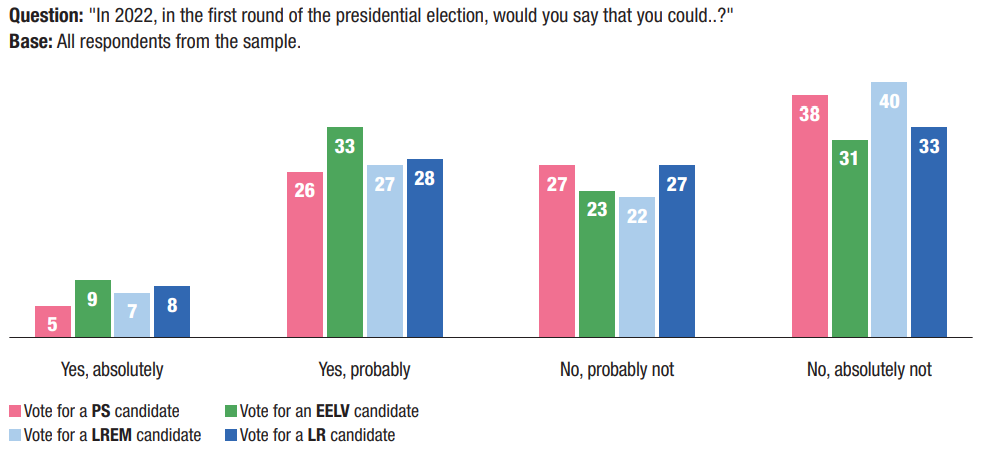
Copyright :
© Fondation pour l’innovation politique – October 2020
Note: The totals do not add up to 100% due to non-responses, which are not included in this graph.
EELV seems to attract a wide range of voters…
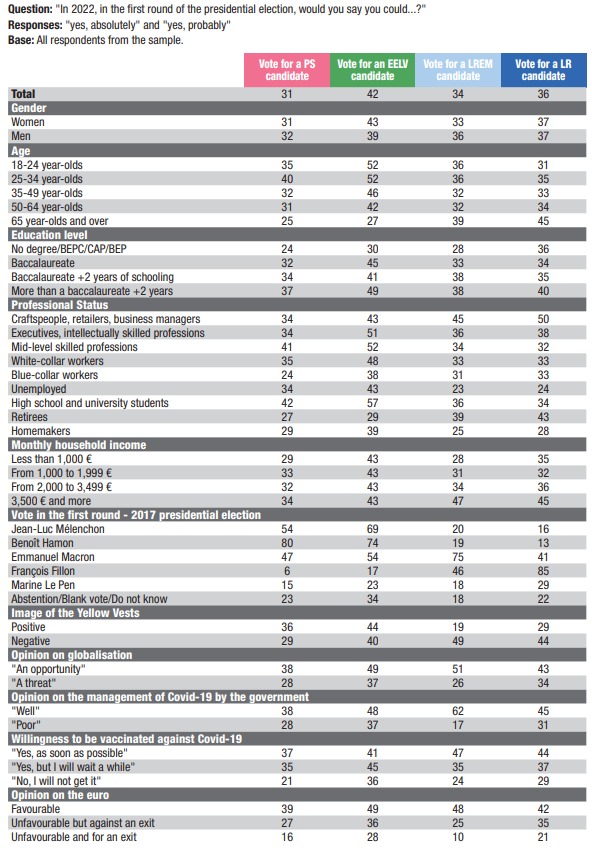
Copyright :
© Fondation pour l’innovation politique – October 2020
…At a time when concern about global warming appears to be sharply declining
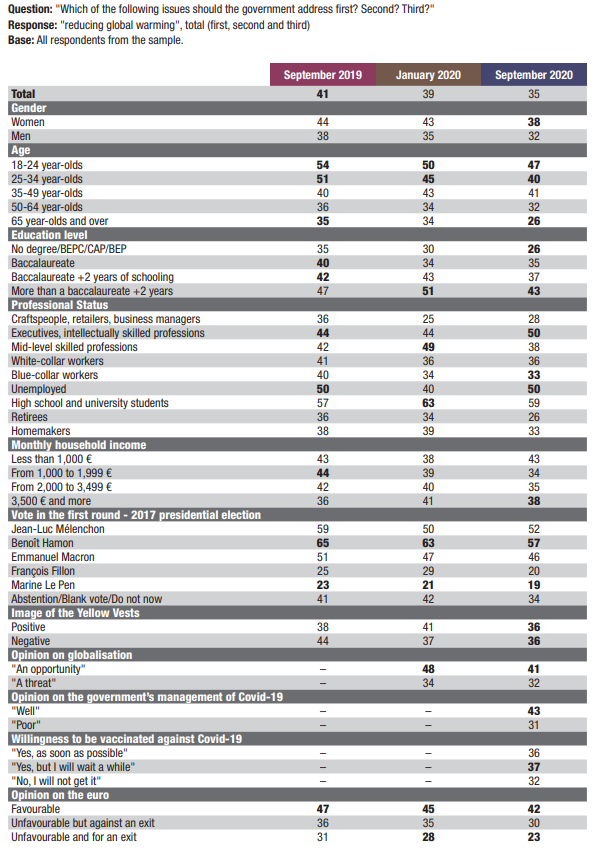
Copyright :
© Fondation pour l’innovation politique – October 2020
The populist risk falls into the process of democratic deconsolidation
More than a third of the French (37%) question representative democracy
As part of our indicator of electoral protest, we asked respondents to rank three systems of government.

Such a level of scepticism about voting (38%) corresponds to the level we measured in France in September 2018 in our international survey Democracies Under Pressure. This proportion was 30% for the average of the 42 surveyed countries and 34% for the average of European Union member states.
The attachment to representative democracy is no longer self-evident. In wave 2 (January 2020), less than two- thirds (64%) of the surveyed population placed the regime of having “a democratic political system with an elected Parliament that controls the government” in first place. Wave 3 (September 2020) shows a decline of 5 points to 59%. This decline in support for the representative democracy model is coupled with scepticism about the usefulness of voting: more than a third of respondents (38%) believe that “voting is worthwhile because elections can make a difference”7. However, neither of the two alternative systems garnered broader support: 25% of respondents rank the system where “citizens decide what is best for the country, rather than the government” as their preferred system, up 3 points from January 2020 (22%). Lastly, a minority (12%) express a preference for “a strong, elected leader, who would decide alone without worrying about what Parliament or the media say,” up 2 points from wave 2 in January 2020 (10%).
Representative democracy is less convincing than in January 2020
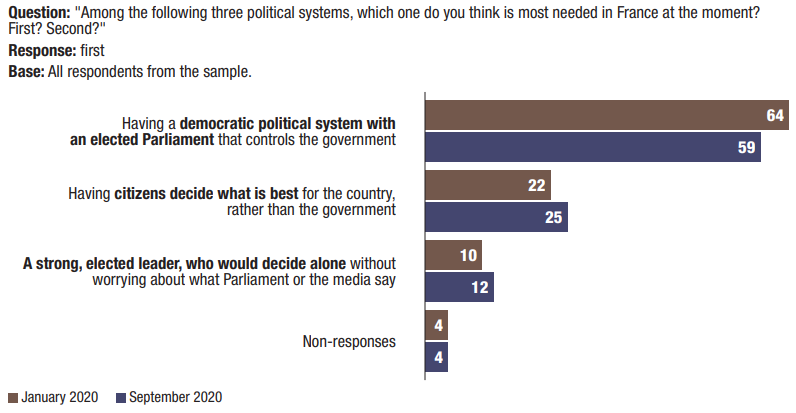
Copyright :
© Fondation pour l’innovation politique – October 2020
The preference for representative democracy is only supported by a relative majority of blue-collar workers, craftspeople, retailers, business managers and the unemployed
Between waves 2 (January 2020) and 3 (September 2020) of our indicator, support for representative democracy declines in all social categories. However, this decline is stronger for those in the upper socio-professional category (i.e. craftspeople, retailers, business managers, executives, those with intellectually skilled professions and mid-level skilled professions), from 65 to 59%, than in the lower socio-professional category (white and blue- collar workers), from 54 to 49%.
Craftspeople, retailers and business managers are the least likely to support the representative regime (38%), ahead of blue-collar workers (44%) and white-collar workers (52%). Respondents belonging to the lower socio-professional category are more favourable (30%) than the average (25%) to a direct democracy type of regime where, according to our questionnaire, “citizens decide what is best for the country, rather than the government”. However, it is also in these categories that the preference for an authoritarian model based on a “strong leader” has broader support (17%) than the average (12%).
Support for different types of political systems according to socio-professional category

Copyright :
© Fondation pour l’innovation politique – October 2020
Preference for electoral democracy also varies according to professional status
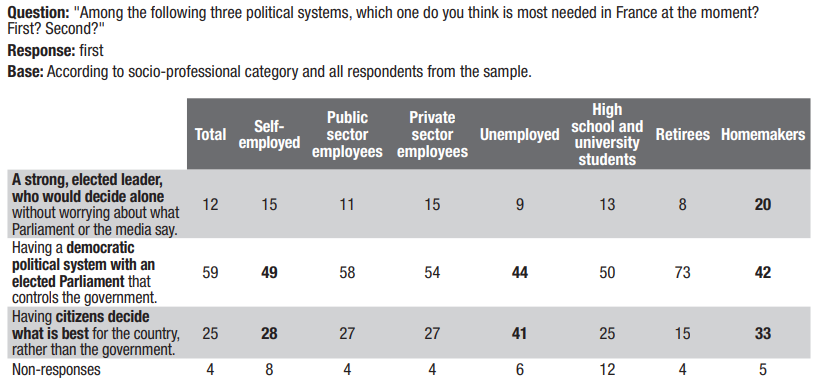
Copyright :
© Fondation pour l’innovation politique – October 2020
In terms of professional status, more people without a professional activity rather than those with a working activity favour the regime of representative democracy (66 versus 54%). A minority of the unemployed (44%), homemakers (42%) and the self-employed (49%) choose representative democracy firstly among the three political systems.
The attachment to representative democracy grows with age
Age is another major fault line. The preference for representative democracy varies greatly from one generation to the next. While almost three-quarters (74%) of those 65 and over still consider our political model to be preferable to the other two, less than half of 18-24 year-olds (46%) and 25-34 year-olds (44%) share this view.
However, when it comes to the preference for a strong elected leader, the notable differences between age groups observed in wave 2 (January 2020) are diminishing. The reduction in the differences is due both to a fall in the proportion of young people declaring a preference for an authoritarian regime, which fell from 16 to 13% among 18-24 year-olds and from 15 to 13% among 25-34 year-olds, and increased in the proportion of those declaring a preference for a “strong leader” that is progressing among the 35-49 year-olds (from 10 to 15%) and the 50-64 year-olds (from 8 to 14%).
Among 35-49 year-olds, the preference for representative democracy dropped sharply (-11 points), from 63 to 52%. In addition to the progress in support for a “strong leader”, this movement of opinion is combined with an increase in preference for a system in which “citizens decide what is best for the country, rather than the government” (from 23 to 27%).
Among 25-34 year-olds, a similar dynamic is at work, with support for representative democracy declining from 51 to 44% in favour of the direct democracy model (from 30 to 39%). This is to be put into perspective with the particularly marked scepticism among 25-34 year-olds, who are the least numerous (54%) to consider that “voting is worthwhile because elections can make a difference”, compared with 60% on average. It is noteworthy that 18-24 year-olds, while few say they prefer representative democracy (46%), nonetheless express, on par with those aged 65 and older, the highest level of attachment to voting of any age group (66%).
The idea of direct democracy is very present among the under 35 year-olds, the over 35 year-olds are more loyal to the representative system
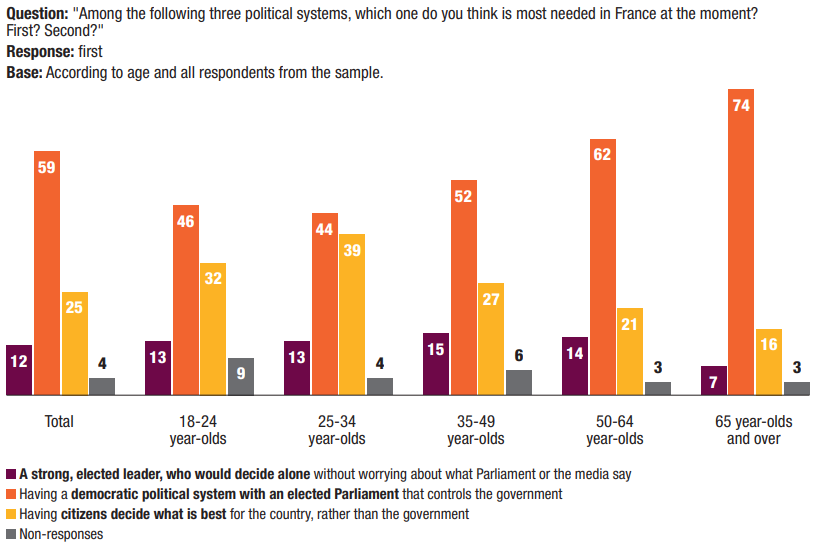
Copyright :
© Fondation pour l’innovation politique – October 2020
Detachment from representative democracy serves right-wing populism
With regard to partisan lines, this detachment from our democratic model can be observed more particularly on both extremes of the political spectrum, especially on the extreme right. The preference for representative democracy concerns 60% of those close to the PCF/LFI and 47% of those close to the RN, well below those close to the PS (75%), LR (76%) and LREM (80%). However, it is important to note that support for representative democracy is also very low among those who declare having no party preference (49%).
This group of respondents who indicated that they did not feel close to any of the proposed parties should not be overlooked as it represents 1,163 respondents, or 38.3% of the sample (3,037 interviewees). They appear to be largely in favour of a regime where “citizens decide what is best for the country, rather than the government” (32%, compared to 25% on average) or, to a lesser extent, a regime with “a strong, elected leader, who would decide alone without worrying about what Parliament or the media say” (15% compared to 12% on average).
LREM supporters are most attached to the representative system, LFI supporters to direct democracy and RN supporters to a strong leader
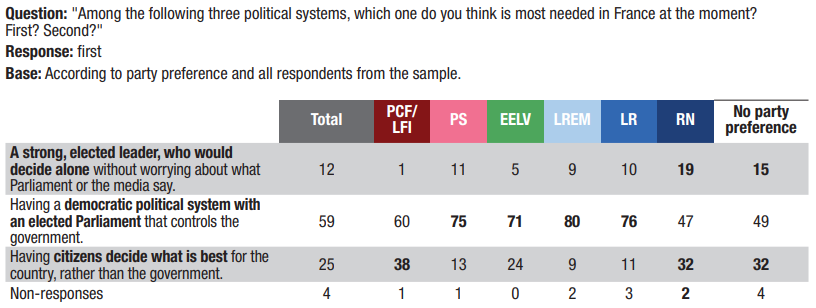
Copyright :
© Fondation pour l’innovation politique – October 2020
Preference for a strong leader appears to be non-existent among PCF/LFI supporters (1%), while it is widely expressed among respondents close to the RN (19%, 7 points above average). Both of these groups are more likely to support a system in which citizens decide what is best for the country rather than the government, whether PCF/LFI supporters (38%) or those close to the RN (32%), compared to 25% on average.
The appetite for a “strong leader” is not exclusively part of a protest dynamic. In fact, 14% of respondents expressing satisfaction with Emmanuel Macron’s action as President believe that a strong leader is necessary in France today, compared to 11% of those who say they are dissatisfied. This preference is not exclusive to the extreme right either, since it is shared, albeit to a lesser degree, by some supporters of the PS (11%), LR (10%), and LREM (9%).
The idea of a government in which the people would decide for themselves aggregates protesting worlds
Respondents favouring a political system where “citizens decide what is best for the country, rather than the government” are characterised by a very negative assessment of their personal situation, a system of protest opinions and very high levels of distrust.
Among respondents who favour a government by citizens, 72% feel that their lifestyle or the way they live is threatened (compared to 60% on average) and 32% say they have difficulty living on their household incomes (compared to 22% on average). More than a third (36%) say they are dissatisfied with their lives (compared with 27% on average).
A large majority (66%) have a positive image of the Yellow Vests (compared with an average of 44%). They believe that “voting is pointless because politicians do not care about the will of the people” (56% compared to 38% on average), express a mistrustful attitude towards globalisation (71% consider globalisation to be a threat, compared to 60% on average) and their opinion on immigration is significantly more negative than average: 68% think that “for France, economically speaking, immigrants are a disadvantage because their integration is expensive” (compared to 60% on average) and 70% think that “most immigrants do not share France’s values and this causes problems of cohabitation” (compared to 63% on average). Within this “direct democracy” group, there is also a high proportion of “anti-vaxxers”: 39% of them say that they would not agree to receive a possible vaccine against Covid-19, even if it had been approved by the French health authorities (compared to 28% on average). Additionally, 30% of respondents preferring a regime where citizens decide what is best for the country rather than the government say they would be in favour of having the right to own a gun in their homes (compared with 23% on average).
It is less surprising to find in this group the highest levels of mistrust of institutions. It should be noted that this marked mistrust goes beyond the government and representative institutions: 88% of these respondents do not trust political parties (compared to 82% on average), 84% do not trust the government (compared to 63% on average), 82% do not trust members of Parliament (compared with 64% on average), 79% do not trust the President (compared to 60% on average), 78% do not trust the media (compared with 72% on average), 67% do not trust unions (compared with 65% on average), 56% do not trust judges (compared with 45% on average), 45% do not trust the police (compared with 28% on average), 33% do not trust mayors (compared with 22% on average) and 31% do not trust scientists (compared with 21% on average).
Above all, this mistrust extends to the interpersonal sphere, a characteristic feature of the populist disposition: 39% do not trust their neighbours (compared to 30% on average) and 36% do not trust the people they work with (compared to 28% on average). The differences between this group and the average are smaller with regard to family (8% do not trust them, compared to 6% on average) and people met on social media (66% do not trust them, compared to 65% on average). Thus, respondents who favour a political system in which citizens make decisions instead of the government are more likely to feel distrustful of others: most (79%) feel that one can never be too careful when dealing with others, compared to 73% on average.
A first look at their envisaged electoral behaviour in the first round of the 2022 presidential election suggests a high potential for electoral protest, directed towards the populist offer on both the right and the left. Indeed, 42% could vote for a RN candidate, 10 points above the average (32%); 26% could vote for a DLF candidate, 5 points above the average (21%); 35% could vote for a LFI candidate, 12 points above the average (23%); and 26% could vote for a LO/NPA candidate, 9 points above the average (17%). The willingness to abstain from voting (57% versus 45% on average) and to vote blank (59% versus 49%) is also very high.
French politics is suffering from a process of democratic deconsolidation. As a result, the protest forces are given a bigger platform. The populist risk therefore seems greater. Our indicator tests six types of protest behaviour: abstaining from voting, voting blank, voting for the RN, LFI, DLF and LO/NPA. Out of all respondents, 4% answered “yes” to each of these options. Yet this proportion is higher among those who favour a regime where citizens decide directly (6%) and doubles (8%) among those who express a preference for the authoritarian model (having a strong leader in power). However, the demand for a strong leader is not exclusively in favour of populist candidates. Among voters expressing a preference for the authoritarian model, 26% say they “will definitely” or are “very likely to” vote for Marine Le Pen in the first round, but 19% say they are willing to vote for Emmanuel Macron. The same situation would be found in the case of a second round that would oppose these two candidates. Among voters expressing a preference for the authoritarian model, 32% said they would vote for Marine Le Pen, but 28% said they would vote for Emmanuel Macron.
Emmanuel Macron, who is therefore also identified as a figure of a “strong leader”, to whom some of those close to LREM seem receptive, as we have seen. On the other hand, among those who express their preference for this authoritarian model, only 9% say they are willing to vote for Jean-Luc Mélenchon in the first round of the presidential election.
In the first round, the preference for “a strong leader” benefits Marine Le Pen first, then Emmanuel Macron, and the preference for a government by the citizens benefits first Marine Le Pen, then Jean-Luc Mélenchon

In the second round, voters who support a regime with a strong leader are split between Emmanuel Macron and Marine Le Pen
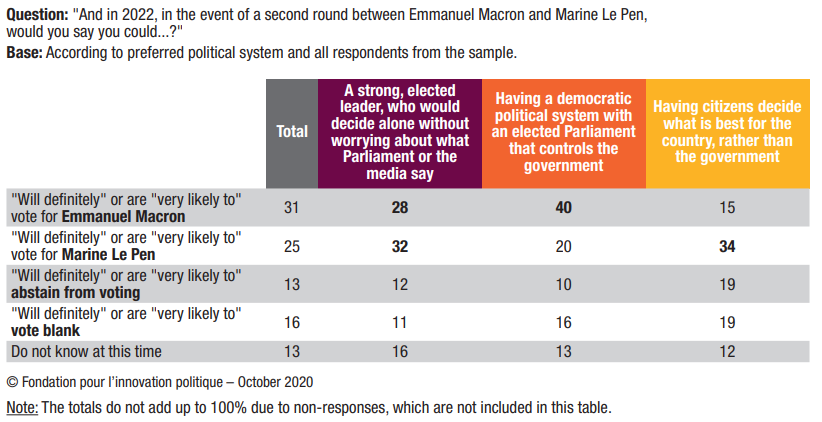
The preference for a regime where “citizens decide what is best for the country, rather than the government” represents a significant fraction of the electorate (25%). However, as we can see, a quarter of this electorate (25%) is inclined to vote for Marine Le Pen in the first round of the presidential election, more than for Jean-Luc Mélenchon (13%), the biggest proponent of a constitutional assembly (a group of representatives tasked with drafting a new constitution), or Emmanuel Macron (8%), who is nevertheless the first president to give responsibilities to a Citizens’ Convention (a panel of French citizens in charge of coming up with policy propositions) chosen at random. Moreover, it is among those who prefer that “citizens decide what is best for the country, rather than the government” that the wish to avoid the re-election of Emmanuel Macron (59%) prevails over the will to avoid the election of Marine Le Pen (37%).
Supporters of a government by the citizens are the most numerous to want above all to avoid the re-election of Emmanuel Macron
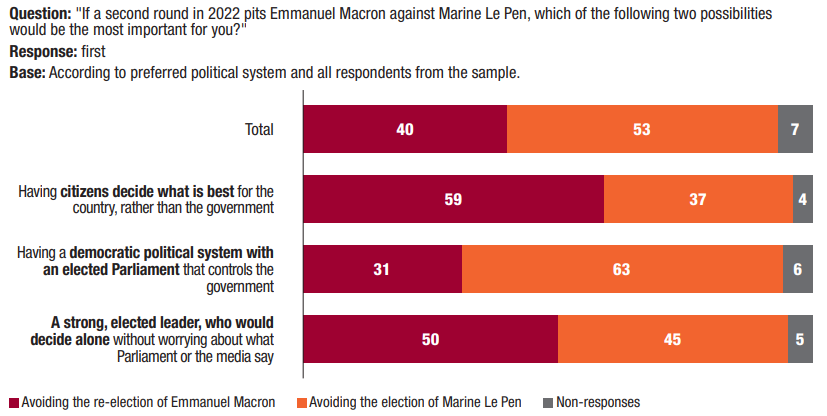
Copyright :
© Fondation pour l’innovation politique – October 2020
Detachment from representative democracy works in favour of right-wing populism. Marine Le Pen’s candidacy appears to be in tune with both an electorate calling for a more authoritarian government as well as an electorate calling for a more direct democracy, probably understood here, at least in part, as integrating referendums into the political system. There remains the electorate expressing a preference for representative democracy, more favourable to Emmanuel Macron (40% “will definitely” or are “very likely to” vote for him in the second round) than to Marine Le Pen (20%). Anything that weakens electoral democracy favours the progress of populism.
The new media, a public space conducive to populism
The democratic public space is subject to structural changes, particularly due to the decline of the traditional press and the advent of a digital space that is more favourable to populism. Our indicator shows that the potential for electoral protest is sensitive to the sources of information of the respondents.
We consider two aggregates: on the one hand, the “traditional media”, bringing together those who get their information from major television channels, 24-hour news channels, newspapers (print or online), or radio; on the other hand, the “new media”, bringing together those who get their information from YouTube, blogs, forums or social networks. It can be observed that the declared willingness to vote for a populist candidate in the first round of the 2022 presidential election is higher among those who inform themselves through these new forms of media. The control of this variable by taking into account the age of respondents confirms a specific effect of the platform of information, particularly in the case of populist voting. This could be a systemic explanatory factor for populist voting in particular and anti-politics in general.

Users of new forms of media are more prone to protest behaviour
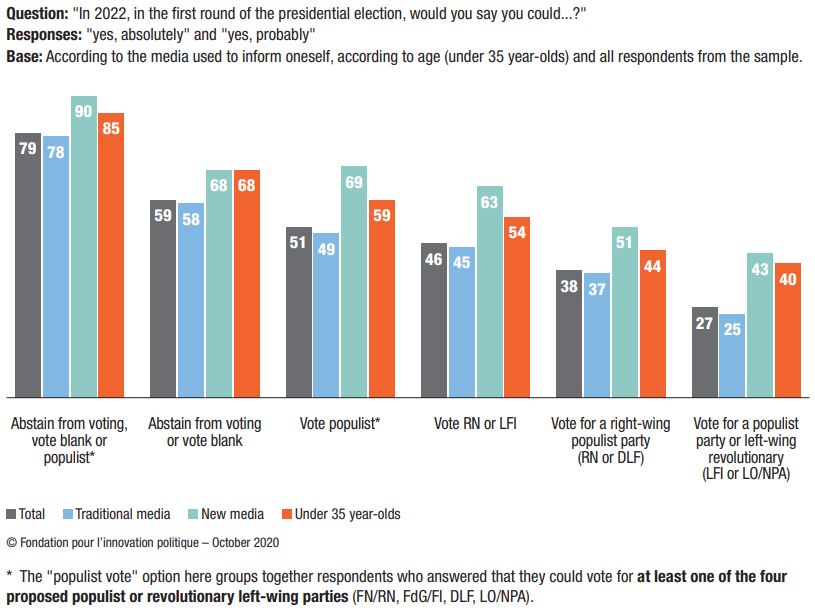

From the very beginning of the lockdown (March-May 2020) in France, there has been a significant increase in the use of the Internet and social media. On this subject, see Valentin Cimino, “Avec le confinement l’utilisation des réseaux sociaux augmente de 61%“, siecledigital.fr, 27 March 2020.
The “new media” effect benefits all protest parties: in the perspective of the first round of the next presidential election, 42% of respondents informing themselves on new forms of media say they could vote for a RN candidate, 10 points higher than the average (32%); 37% could vote for LFI, 14 points higher than the average (23%); 30% could vote for DLF, 9 points higher than the average (21%); and 28% could vote for LO/NPA, 11 points higher than the average (17%). Between waves 2 (January 2020) and 3 (September 2020), the proportion of voters informing themselves on new forms of media who plan to vote for RN in the first round increased from 36 to 42%.
Again, between waves 2 and 3, this evolution accompanied a phenomenon of increased right-wing political activity on social media, which constituted a significant portion of the information consumed via new forms of media. Indeed, during wave 2 (January 2020), 25% of respondents on the left of the political spectrum and 23% of those on the right said they discussed the news “often” or “from time to time” with people they “met on social media”. In wave 3, in September 2020, a right-wing trend is visible, with 16% of left-wing respondents reporting discussing current events with other people on social media, compared to 27% of right- wing respondents.
In order to account for this evolution, one must at least hypothesise the contextual factor and political agenda. The beginning of the year 2020, at the time wave 2 was administered, was dominated by movements opposed to the retirement reform that favoured stronger left-wing activity online, while the fall of 2020 was dominated by the pandemic, to which was added a rise in themes related to security issues, criminal behaviour, Islam and immigration, mobilising a much more right-wing electorate online.
The risk of a “sounding board” effect on social media
An inquiry into the way the French inform themselves reveals two worlds, shared between traditional and new forms of media, notably social media, as a new public space. Beyond those who claim to use them as a means of getting informed, many citizens cross these spaces and interact in them, including to exchange about current events8: 21% of those who use social media discuss “often” or “from time to time” what’s going on in the country with the people they meet online.
It is therefore appropriate to look at the profiles of these populations and, in particular, at the dynamics of politicisation that animate social networks.
An initial look at socioeconomic characteristics confirms that young people are the most numerous to regularly discuss how things are going in France on social media: this concerns 30% of 18-24 year-olds and 29% of 25-34 year-olds, compared with 23% of 35-49 year-olds, 18% of 50-64 year-olds and 14% of those aged 65 and over. There is no difference between men and women (21% in both cases), nor between upper socio-professional and lower socio-professional categories (24 versus 22%).
Compared to the average, they are also populations that are closer to the extremes and that show an openness to populism. In fact, around a quarter of the respondents who voted for Jean-Luc Mélenchon (23%) and Marine Le Pen (25%) in the first round in 2017 discussed what’s going on in the country “often” or “from time to time” on social networks. By way of comparison, this concerns 20% of people who voted for Emmanuel Macron, 20% of people who abstained from voting, voted blank or did not wish to respond, 15% of those who voted for François Fillon and 11% for Benoît Hamon.
Given the algorithms governing social networking platforms and the suspected effects of the polarisation of opinions, it is worth asking to what extent respondents encounter opinions contradictory to their own when exchanging views on these networks.

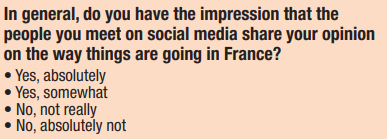
A distinction must be made between those who say they use social media for discussion and those who say they also use them for information. We discovered that 50% of people using social media simply to “discuss the way things are going in the country” say they feel that the people they meet online share their opinions. However, among those who say they use social media as a means to inform themselves, a very large majority (62%) believe that the people they meet share their opinions. This result is particularly worrisome in the sense that the social network is used here as a means of information and we now know that the posting of content is subject to rules that favour a “sounding board” effect that deteriorates the quality of the information circulating on a social network.
This phenomenon is found among the potential populist electorate: 55% of those who say they could vote for the RN in 2022 say that the people with whom they interact on social media share their opinions, compared to 50% on average; the same is true (57%) for respondents who say they could vote for a LFI candidate.

Memo for the reader: among all the respondents, 50% feel that the people they meet on social media share their opinions on the way things are going in France. Among the people who could vote for a RN candidate in the first round of 2022, 55% feel that the people they meet on social media share their opinions on the way things are going in France.
On social media, protesting worlds are more likely to find opinions convergent with their own
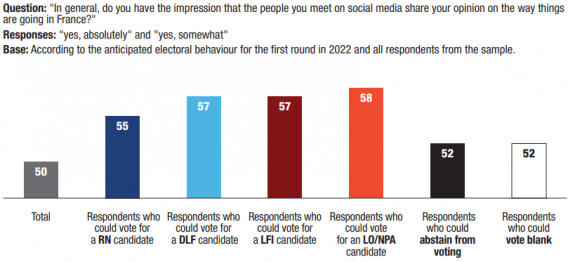
© Fondation pour l’innovation politique – October 2020
Regarding a future first round wherein Marine Le Pen, Jean-Luc Mélenchon and Emmanuel Macron would be candidates, 58% of those who believe they “will definitely” or “will most likely” vote for Marine Le Pen consider that the people they meet on social media share their opinions on current events. This impression is shared by 61% of those who would vote for Jean-Luc Mélenchon and 43% of those who would vote for Emmanuel Macron. Furthermore, among the voters who say they “will definitely” or are “very likely to” vote for Marine Le Pen in the second round in 2022, 57% feel that the people they meet on social media share their opinions on how things are going in France.
This concerns 38% of those who “will definitely” or are “very likely to” vote for Emmanuel Macron. The results of our barometer confirm that social media are a new public space particularly favourable to the circulation and sharing of protest and populist opinions, between users whose convergent views are radicalised by a process of mutual reinforcement, an effect often referred to as the “sounding board” or “filter bubble” effect.
The resources of electoral protest
Society is perceived as increasingly violent
Three-quarters of respondents (72%) feel that society is “increasingly violent”

Copyright :
© Fondation pour l’innovation politique – October 2020
See “Insécurité et délinquance en 2019: une première photographie“, Interstats Analyse, no. 24, January 2020.
Inevitably, with such a high level (72%), this opinion is present in all social categories, but slightly more so among women (73%) than men (71%), more overwhelmingly present among those aged 65 and over (77%) than among 18-24 year-olds (59%), where it nevertheless continues to be in the majority. This opinion is shared by three-quarters of rural residents (75%), but is also very prevalent in cities with morethan 100,000 inhabitants (71%), notably Paris (69%). This dominant feeling is found across the political spectrum, although it is more pronounced on the right. It should be noted that the feeling of an increase in violence is part of a reality documented by the statistics of the Ministry of the Interior9. The crime rate increased sharply in 2019.
The idea that society is “increasingly violent” dominates, both on the left and on the right

Copyright :
© Fondation pour l’innovation politique – October 2020
Memo for the reader: among those close to the PCF/LFI, 57% believe that society is “increasingly violent”, 39% believe that it is “as violent as in the past” and 4% believe that it is “less and less violent”.
Voters who consider society to be increasingly violent tend to vote for Marine Le Pen

Copyright :
© Fondation pour l’innovation politique – October 2020
This representation of a rising and unsettled conflictual atmosphere can be fuelled by 24-hour news television channels or by social media, which stage acts of violence on an almost daily basis. This trivialisation of violence by the new media may lead part of the public to want to distance themselves from these images: 43% of people respondents believe that “the media talk too much about violence in our society, they should talk about it less”, compared to 16% who think that “the media do not talk enough about violence in our society, they should talk about it more”. Almost 4 in 10 French people (38%) think that “the media talk neither too much nor not enough about violence in our society”.
43% of the French consider that the media talk too much about violence

Copyright :
© Fondation pour l’innovation politique – October 2020
See Sandra Laffont, “Violence, réputation, blasphème… : au collège, l’éducation aux médias face au pouvoir des smartphones“, lemonde.fr, 4 September 2020.
According to a 2018 survey, the use of screens, social media and video games is spectacularly high among young people, with a quarter (26%) of 18-22 year-olds estimating that they spend more than 5 hours a day on social networks and 10% more than 8 hours each day. See Les Addictions chez les jeunes (14-24 ans). L’urgence d’une politique de santé et de sécurité publiques, Fondation pour l’innovation politique- Fondation Gabriel Péri-Fonds Actions Addictions, June 2018.
This number may seem contradictory. However, it leaves open the possibility of an interpretation that would not imply inconsistency of opinion or a flaw in the measure: society is increasingly violent and the media talk too much about it in a way that would be considered inappropriate. For example, the coverage would be reduced to an observation whose repetition would provide no way out, no vision on how to reverse such a trend, and end up disappointing or discouraging some, and exasperating others.
It should also be noted that a quarter of 18-24 year-olds (25%) consider that the media do not cover the topic of violence enough and that they should talk about it more, 9 points higher than the average (16%) of the sample. One of the explanations may be found in the abundant sharing of videos on cell phones of high school students via social media, such as Snapchat or Instagram, and which can be extremely violent, as a recent report10 pointed out. Scenes of torture, looting, burning cars and fights are thus spread among the youth, who may perceive a discrepancy between what they have access to11 and what they see in traditional media sources.
Younger people are the most likely to consider that the media do not talk enough about violence

Copyright :
© Fondation pour l’innovation politique – October 2020
For the question “Which of the following issues should the government address first? Second? Third?”, respondents were asked to respond by ranking (first, second or third) three of the seven proposed options. In analysing the results, we have used the “total” here, which represents the percentage of respondents who mentioned one of these options, either first, second or third, within the list of seven options.
Furthermore, we note that respondents close to the RN are twice as numerous (34%) as the average of the sample (16%) and five times as numerous as respondents close to the PCF/LFI (6%) to consider that “the media do not talk enough about violence in our society”.
Security is already a key issue for 2022
Among the concerns tested, safety emerged as a central theme. Between waves 1 (September 2019) and 3 (September 2020), to the question “Which of the following issues should the government address first? Second? Third?12“, the answer “reducing criminal behaviour” shows the highest increase (up 16 points, from 34 to 50%). In September 2020, a majority of French people (50%) therefore consider the problem of criminal behaviour to be one of the priorities that the government must address, behind unemployment (54%) but ahead of the other problems: social inequalities (41%), immigration (37%), global warming (35%), the influence of Islam (33%) and government debt/deficit (28%).
List of priorities: unemployment and criminal behaviour at the top
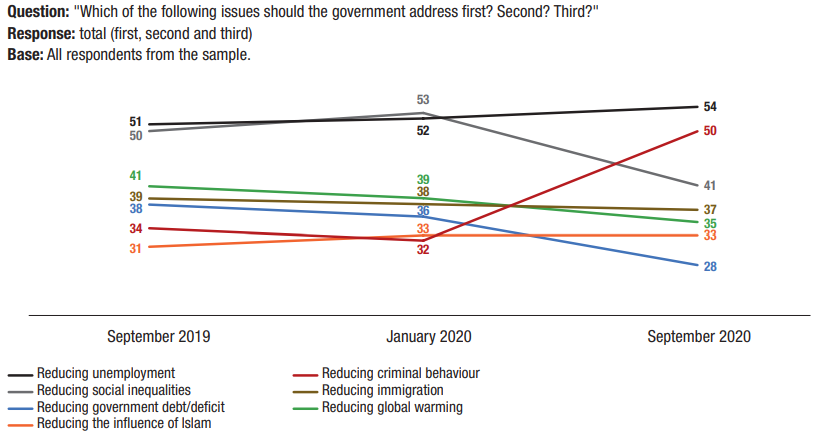
Copyright :
© Fondation pour l’innovation politique – October 2020
In one year, a leap in concern over security
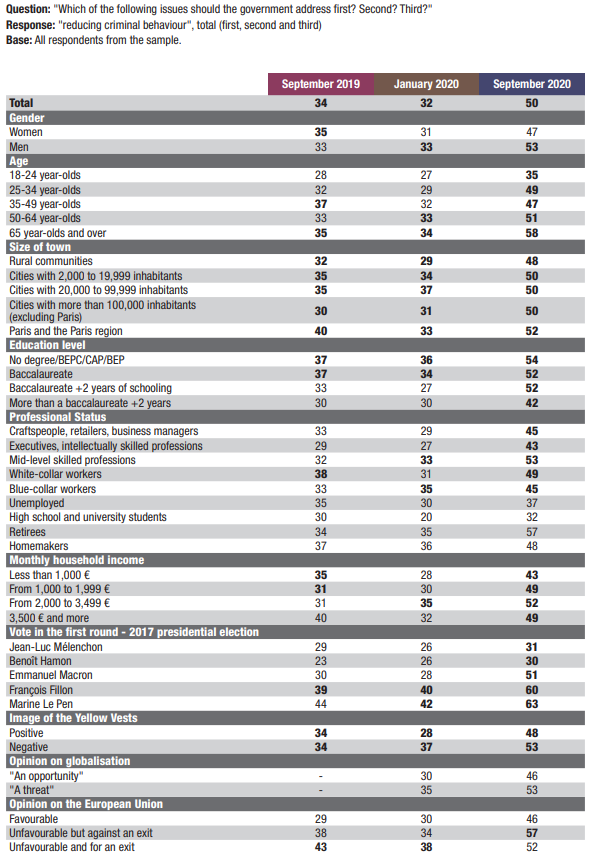
Copyright :
© Fondation pour l’innovation politique – October 2020
Thus, in one year, from September 2019 to September 2020, our barometer recorded a 10 point drop in the need to reduce the government debt/deficit (from 38 to 28%), a 9 point drop for the need to reduce inequalities (from 50 to 41%), a 6 point drop for the need to reduce global warming (from 41 to 35%) and a 2 point drop for the need to reduce immigration (from 39 to 37%). On the other hand, there was a 2 point increase for the need to reduce the influence of Islam (from 31 to 33%), and a 3 point increase for the need to reduce unemployment (from 51 to 54%), all of which was dominated by the 16 point increase for the need to “reduce criminal behaviour” (from 34 to 50%).
Among those who believe that “reducing criminal behaviour” should be one of the government’s priorities, 38% say they might vote for a RN candidate in the first round of the 2022 presidential election, 6 points higher than the average (32%). By contrast, only 17% say they would vote for a LFI candidate, 6 points lower than the average (23%). The fight against criminal behaviour will be a decisive issue if there is a second round between Emmanuel Macron and Marine Le Pen in 2022. Indeed, the rise in security concerns would likely erode the opposition to the election of Marine Le Pen and, symmetrically, encourage the mobilisation of voters hostile to Emmanuel Macron.
In 2022, the security question would play to the advantage of Marine Le Pen in a second round against Emmanuel Macron
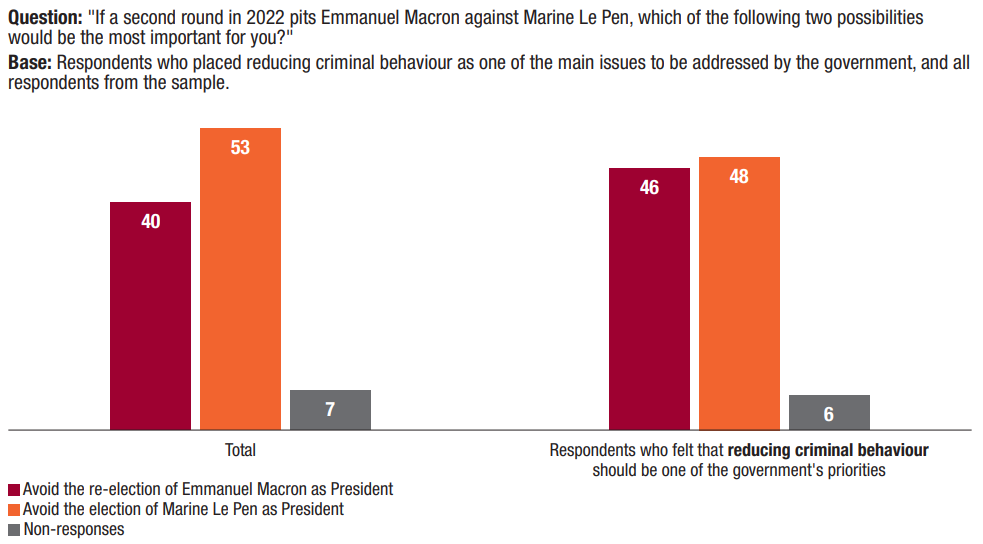
Copyright :
© Fondation pour l’innovation politique – October 2020
Everyone (or almost everyone) loves the police… and would like to see their resources increased
Police officers are favoured highly in public opinion (69% of respondents say they trust them), even if there are generational differences: 75% of French people aged 50 and over trust the police, compared with 56% of those under 35. Furthermore, respondents who are “very left-wing” on the political spectrum express the most critical opinion of the police (only 42% trust the police, compared with 76% of respondents who are “very right-wing” on the political spectrum).
Trust in the police is more widespread in rural municipalities and in cities with less than 100,000 inhabitants. In cities with less than 2,000 inhabitants, 74% of the respondents trust the police, 71% in cities with 2,000 to 19,999 inhabitants, 73% in cities with 20,000 to 99,999 inhabitants and 67% in cities with more than 100,000 inhabitants (excluding Paris, where 63% of the inhabitants trust the police).
Among those who consider that the police do not have enough resources, 23% wish to have the right to own a gun in their homes
In connection with the expression of this confidence in the police, more than three-quarters of those surveyed (77%) believe that the police do not have enough resources to ensure security in France. Among those who consider that the police do not have enough means, almost a quarter (23%) would like to have the right to possess a gun in their homes. Those under 35 years of age are the most favourable (30%), i.e. 8 points more than those aged 50 and over (22%). This opinion is also more widespread among those with fewer qualifications (27% compared with 16% for those with a higher education diploma) and those living in the most modest households (28% for households with less than 2,000€ per month compared with 17% for households with 3,500€ or more per month). There are wide variations dependent on party affiliation, but the figure of 22% among those who declare having no party preference is particularly noteworthy.
* Proportion of the sample who consider the police to be under-resourced (77%).
Note: this question was asked to respondents who answered “does not have enough resources” to the question “In your opinion, in France, to ensure security, would you say that the police…?” (response options: “has too many resources”, “has enough resources” and “does not have enough resources”). This constitutes a sample of 2,331 individuals out of the 3,037 respondents.
RN supporters are the most favourable to “the right to own a gun in their homes”
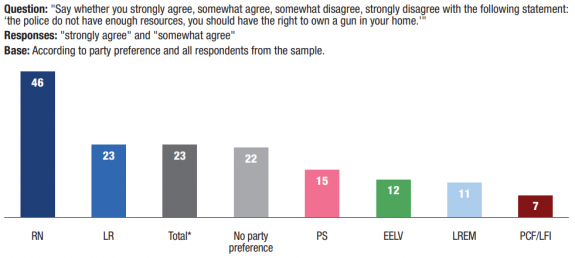
© Fondation pour l’innovation politique – October 2020
Among the respondents in favour of the right to own a gun in their homes, almost all (89%, compared with 79% on average) plan to adopt one of the six protest behaviours proposed in the first round of the next presidential election (abstention from voting, voting blank, voting for one of the populist or anti-system parties, i.e. RN, LFI, DLF, LO/NPA). The majority (57%) of respondents who wish to have the right to own a gun in their homes would vote for the RN in the first round in 2022, compared with 32% on average. Only 16% would vote for the LFI, compared to 23% on average. In the event of a second round in 2022 between Emmanuel Macron and Marine Le Pen, 45% of respondents in favour of the right to own a gun would vote for the RN candidate (versus 25% on average), 18% would vote for the current President (versus 31% on average), 24% could abstain from voting or vote blank (versus 29% on average), and 12% do not yet know what they would do (versus 13% on average).
The choice of a protest vote is asserting itself among voters who have a positive image of the Yellow Vests
Since the first demonstrations in October 2018, the Yellow Vests movement has barely weakened in public opinion. It seems to have become a structural element of the French protest landscape. It is a radically atypical social and political movement, unprecedented under the Fifth Republic. In a complete break with the traditional representative bodies, with no organisation or programme, the Yellow Vests continue to embody a movement that rejects institutions.
The Yellow Vests movement continues to be viewed positively
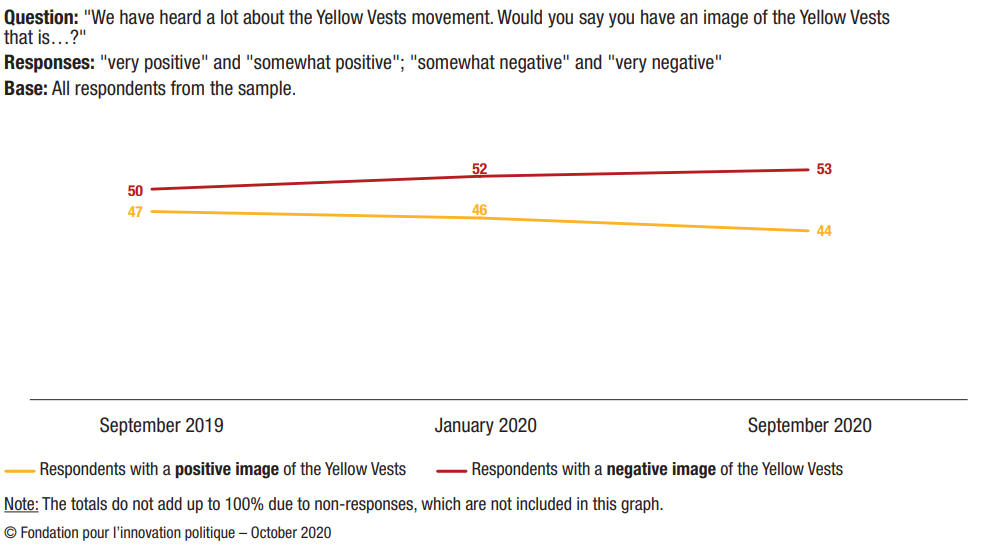
Our survey shows that after two years of existence, this unprecedented movement continues to be viewed positively among 44% of the French, even if there has been a moderate but consistent decline since the first wave of our electoral protest indicator (47% in September 2019, 46% in January 2020).
Support for the Yellow Vests remains particularly high among PCF/LFI supporters (80%), RN supporters (63%) and, to a lesser extent, PS supporters (50%), EELV supporters (49%) and respondents with no party preference (46%). Support is lowest among LR (27%) and LREM (10%) supporters.
French people who have a positive image of the Yellow Vests tend to be more distrustful of institutions than the average of the sample
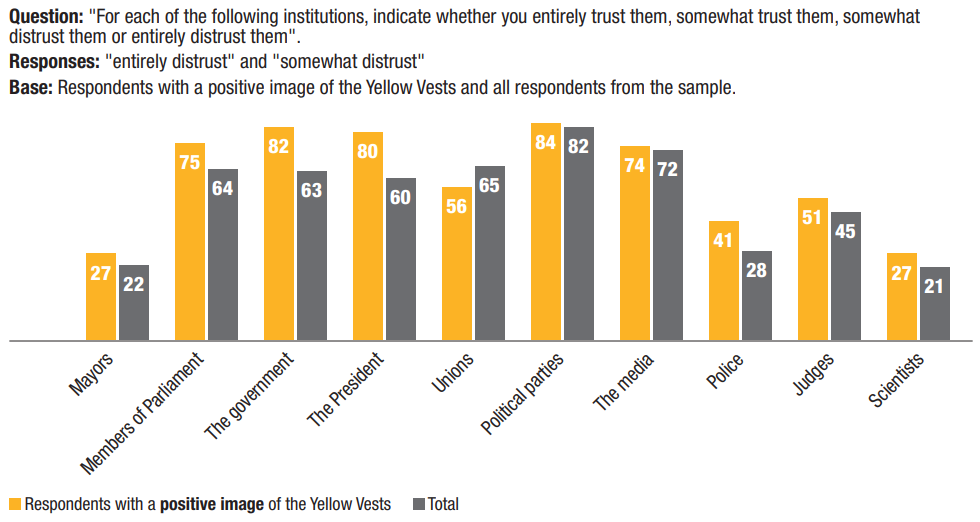
Copyright :
© Fondation pour l’innovation politique – October 2020
Wave after wave, the choice of a protest vote for 2022 is asserting itself among voters who have a positive image of the Yellow Vests. In September 2020, a strong majority (65%) declare they would vote RN or LFI in the first round of the next presidential election, 19 points above the average (46%), compared with 63% in wave 2 (January 2020) and 59% in wave 1 (September 2019). In the same vein, the results of wave 3 (September 2020) show that 66% of people with a positive image of the Yellow Vests say they could abstain from voting or vote blank, compared to 61% in January 2020 and 62% in September 2019. In the event of a second round between Emmanuel Macron and Marine Le Pen, the majority (61%) of respondents who have a positive image of the Yellow Vests would primarily want to avoid the re- election of Emmanuel Macron, compared to one-third (33%) who say they want to avoid the election of Marine Le Pen.
French people who have a positive image of the Yellow Vests are more likely to vote Marine Le Pen than Jean-Luc Mélenchon in 2022
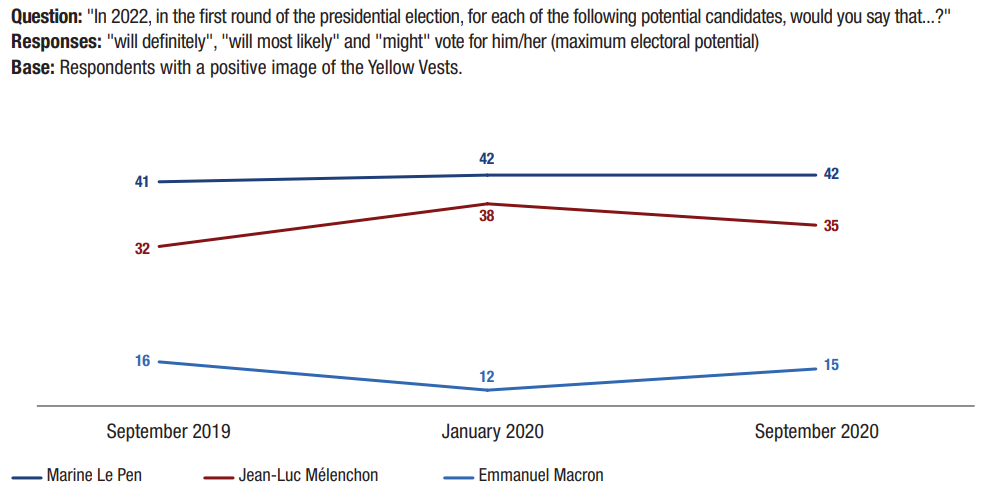
Copyright :
© Fondation pour l’innovation politique – October 2020
Positive image of the Yellow Vests fuels voting against Emmanuel Macron
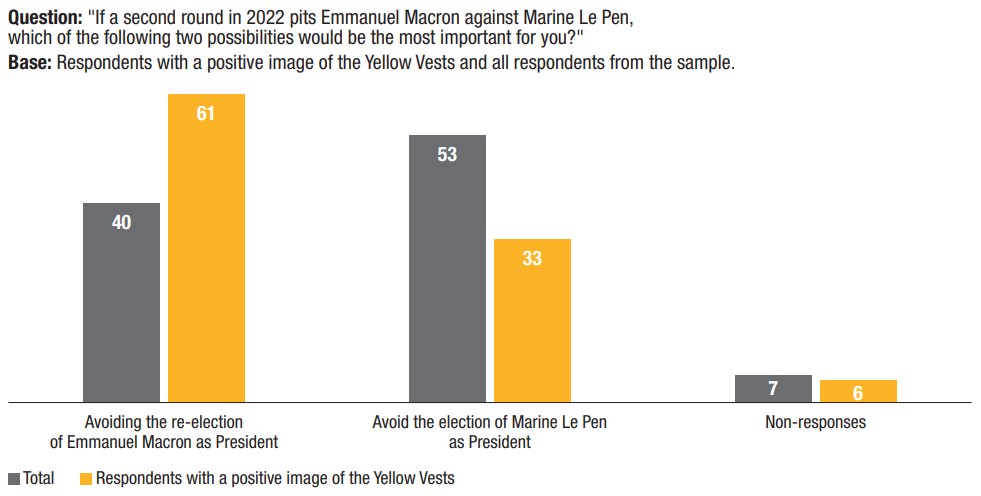
Copyright :
© Fondation pour l’innovation politique – October 2020
The health crisis reinforced a rejection of globalisation
A clear majority of French respondents (60%) perceive globalisation as a threat. The coronavirus pandemic is both a paradigmatic example of the risk of being “without borders”, fostered by international flows of people and goods, and the embodiment of people’s dependence on globalisation. Our indicator shows that the coronavirus is having a definite, and still ongoing, impact on French public opinion’s assessment of globalisation.
In September 2020, when asked respondents to choose between the following two proposals, “globalisation is a threat” and “globalisation is an opportunity”, a majority of respondents (60%) chose “globalisation is a threat”, an increase of 3 points (57%) compared to wave 2 (January 2020). Only one-third (34%) of respondents see globalisation as “an opportunity”, while a high proportion chose not to answer the question (6%).
In September 2020, most (60%) of citizens perceive globalisation as a threat
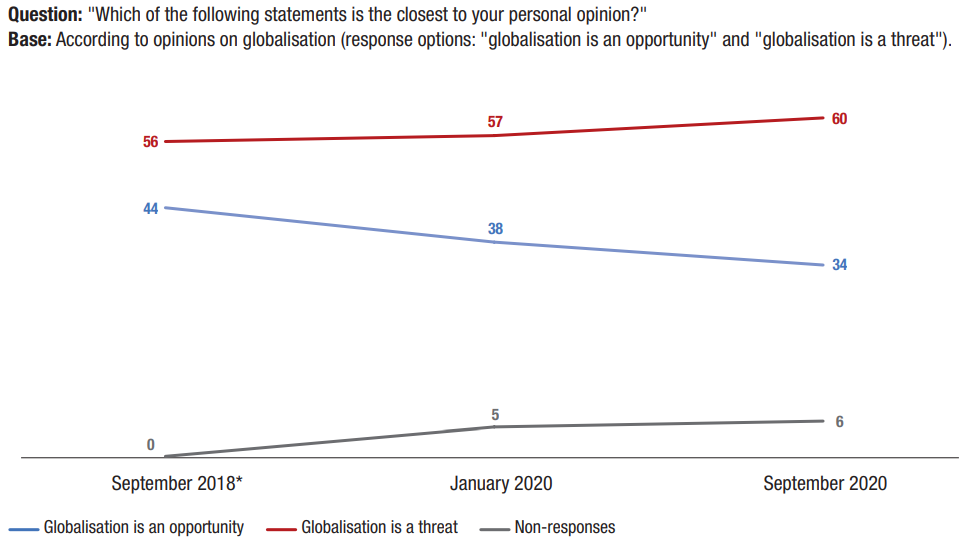
Copyright :
© Fondation pour l’innovation politique – October 2020
With the exception of 18-24 year-olds, among whom it is a minority (43%), the perception of globalisation as a threat is a majority opinion among all other age groups: among 25-34 year-olds (56%), 35-49 year-olds (61%), 50-64 year-olds (65%) and those aged 65 and over (61%). The relationship to globalisation varies according to the level of education, but is never very favourable.
It is true that its perception as a threat concerns three- quarters (73%) of people without a degree or with a BEPC, CAP or BEP degree, with only 47% of those with a level above having a baccalaureate degree seeing globalisation as an opportunity, as opposed to 46% who see it as a threat.
Globalisation is of particular concern in rural France
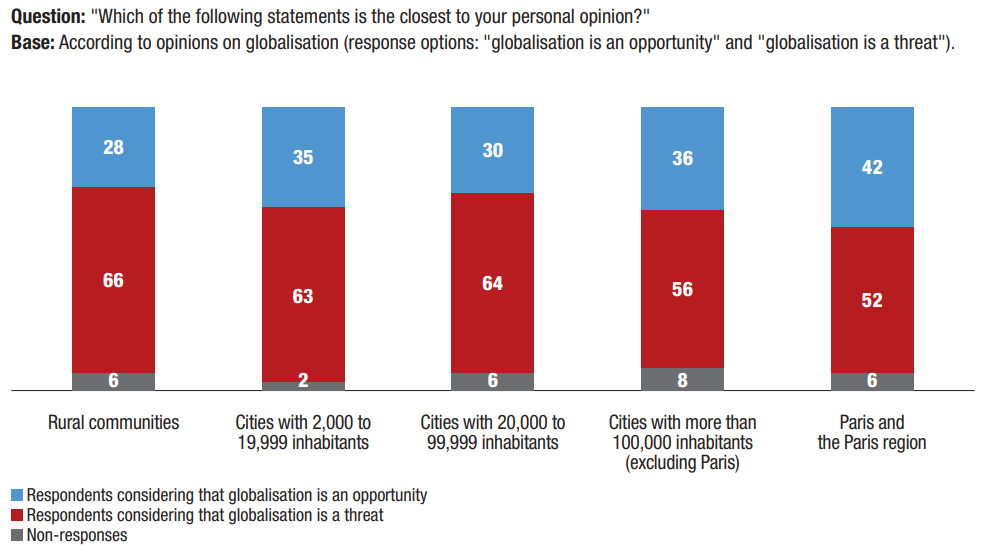
Copyright :
© Fondation pour l’innovation politique – October 2020
Hostility to globalisation is much more widespread among RN supporters (81%), PCF/LFI supporters (67%) and those with no party preference (64%), but it remains in the majority among those close to LR (54%), PS (53%) and EELV (52%).
Among LREM supporters, only 34% believe that “globalisation is a threat”. They are the only ones to consider globalisation as an opportunity (64%).
Memo for the reader: of those who believe that globalisation is an opportunity, 65% consider that reducing unemployment should be one of the government’s priorities; of those who believe that globalisation is a threat, 50% consider that reducing unemployment should be one of the government’s priorities.
The fear of globalisation is that of a France that is more afraid of criminal behaviour, immigration and Islam
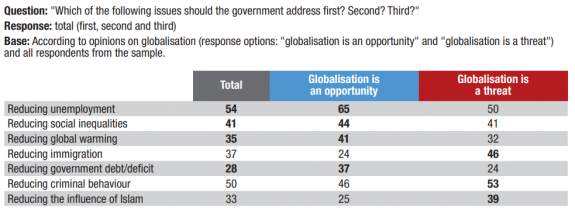
© Fondation pour l’innovation politique – October 2020
Fear of globalisation fosters electoral protest
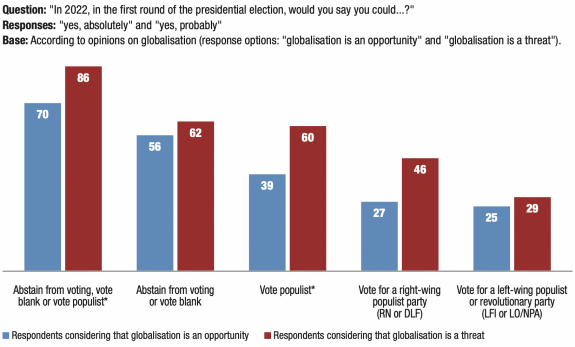
© Fondation pour l’innovation politique – October 2020
* The “populist vote” option here groups together respondents who answered that they could vote for at least one of the four proposed populist or revolutionary left-wing parties (RN, LFI, DLF, LO/NPA).
More French people worried about globalisation will vote for Marine Le Pen in the second round of the presidential election
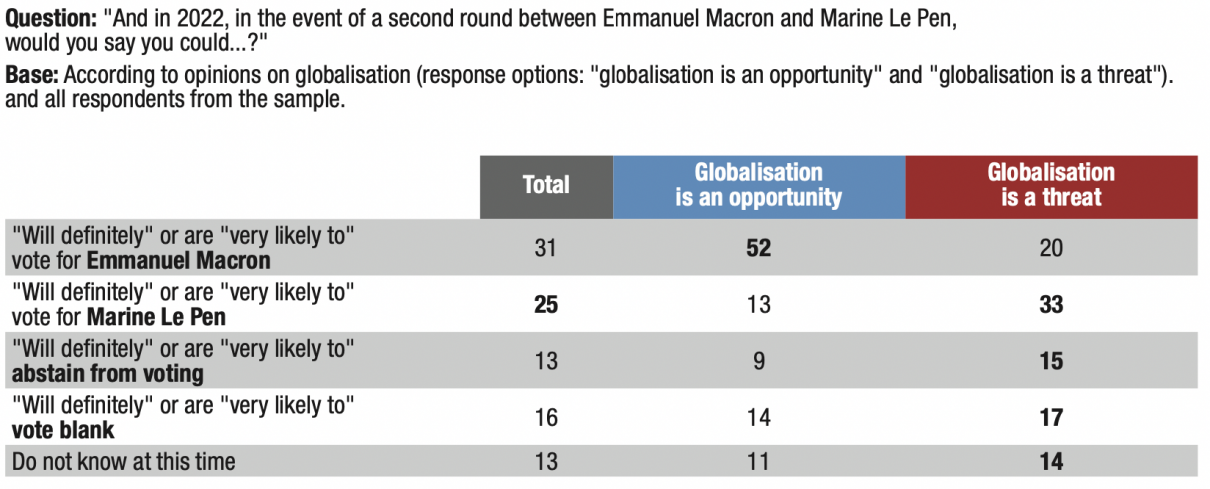
Copyright :
© Fondation pour l’innovation politique – October 2020
Note: The totals do not add up to 100% due to non-responses, which are not included in this table.
On the link between distrust, both of institutions and of society, and populism, see Yann Algan, Elizabeth Beasley, Daniel Cohen and Martial Foucault, Les Origines du populisme. Enquête sur un schisme politique et social, Seuil, 2019; Ilvo Diamanti and Marc Lazar,Peuplecratie.
La métamorphose de nos démocraties, Gallimard, 2019; Dominique Reynié, op. cit., Pluriel, 2016
In terms of mistrust of others or interpersonal distrust, our indicator of electoral protest paints a picture of a community where everyone is distrustful of others. When respondents are asked to choose whether, in general terms, “you cantrust most people” or “you can never be too careful when dealing with others”, three- quarters of the French respondents (73%) choose the latter option.
The level of mistrust is always higher among women. 77% of women responded that “you can never be too carefulwhen dealing with others”, compared to 69% of men. It is also higher among those aged under 35 (75%) than among older people (66% of those aged 65 and over). Furthermore, education plays an important role here as well: there is a 21 pointdifference between those without a degree or with a BEPC, CAP or BEP degree and those with a degree above abaccalaureate +2 years of schooling (82% and 61% respectively). Also, depending on the socio-professional category, the percentage of distrust varies from 81% for those in the lower socio-professional category to 68% in the uppersocio- professional category.
This mistrust of others often combines Euroscepticism and a negative view of immigration. Indeed, among those respondents who consider that one can never be too careful when dealing with others, three-quarters (73%) believe that “most immigrants do not share France’s values and this causes problems of cohabitation” (compared to 39% of those who think that most people can be trusted) and 70% feel that “for France, economically speaking, immigrants are a disadvantage because their integration is expensive” (compared to 38% of those who think that most people can be trusted). Concerning theEuropean Union, barely half (48%) of those who are distrustful are in favour of the European Union (compared to 70% of those who are trustful of others).
Put into the perspective of the 2022 presidential election, interpersonal distrust feeds abstention from voting and blank voting, as well as a readiness to vote RN14. Indeed, in the first round, more than a third of those who believe that”you can never be too careful when dealing with others” (36%) responded that they would vote for a RN candidate, 14 points higher than respondents who believe that “you can trust most people” (22%). In contrast, the dynamics are reversed for left-wing populist or revolutionary parties, with fewer distrustful voters than trustful ones considering voting for LFI (21% versus 29%) or LO/NPA (16% versus 23%).
In the hypothesis of a second round opposing Emmanuel Macron to Marine Le Pen, the distrustful are split between Marine Le Pen (28%), Emmanuel Macron (28%) and abstention from voting or blank voting (29%).
Interpersonal mistrust increases susceptibility to right-wing populism
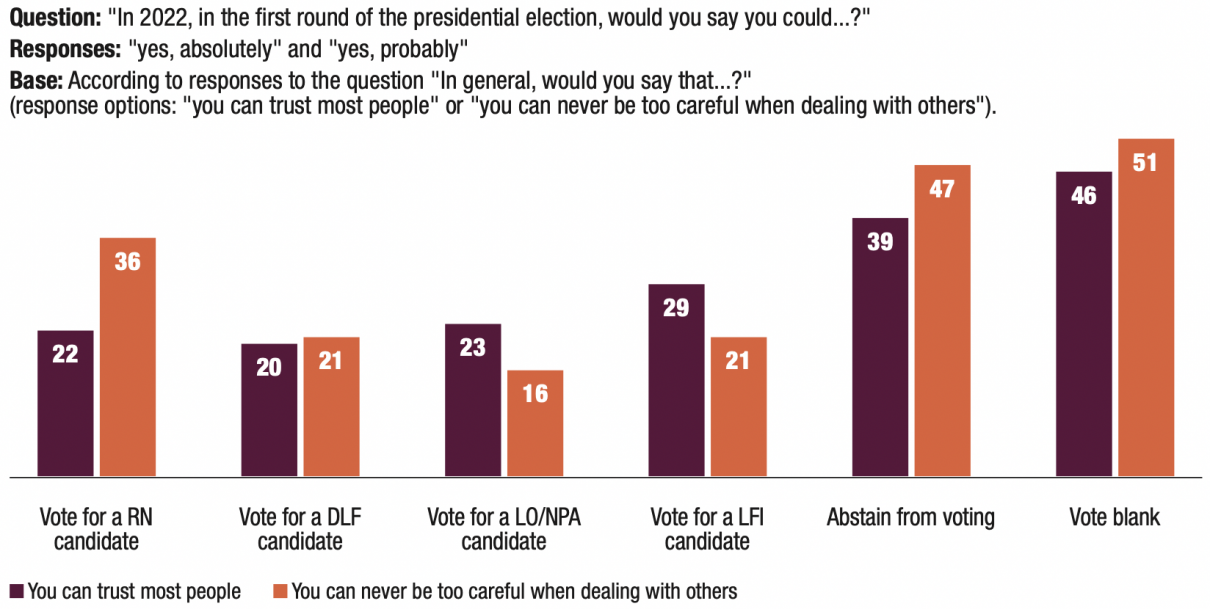
Copyright :
© Fondation pour l’innovation politique – October 2020
In the second round, voters who are distrustful of others are divided between Emmanuel Macron andMarine Le Pen
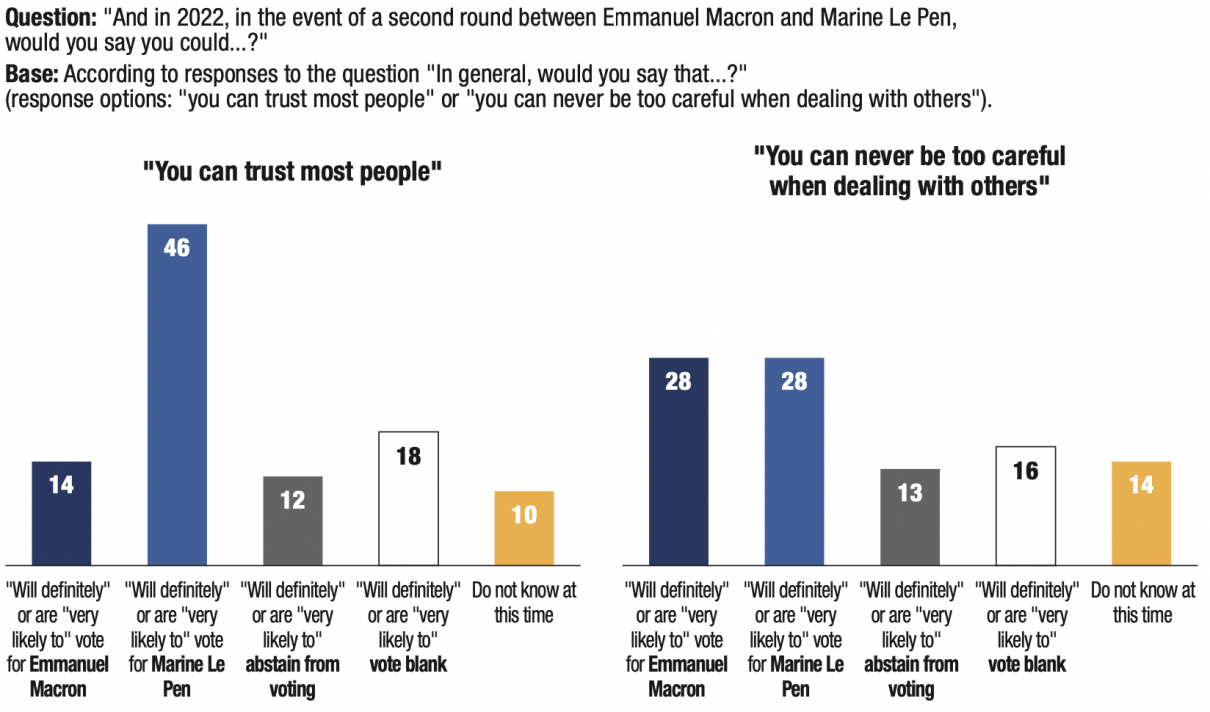
Copyright :
© Fondation pour l’innovation politique – October 2020
When considering the difference between strangers and people in one’s immediate circle, 65% of respondents do not trust the people with whom they interact on social media, 64% do not trust people they meet for the first time, 30% do not trust their neighbours, 28% do not trust the people they work with, but only 6% do not trust their family.
Interpersonal mistrust is growing (January 2020-September 2020)

Copyright :
© Fondation pour l’innovation politique – October 2020
The results seem to bear witness to the pandemic, its manifestations and consequences. We can perhaps see an effectthe March-May 2020 lockdown had in the slight decline in distrust of neighbours, who have somehow become closer to us, while working from home has distanced us from those we typically find ourselves “face- to-face” with. The deterioration of trust in those with whom one exchanges on social media could be the result of an intensification of these exchanges in a context of particularly worrisome, overabundant, incessantly changing and too often incoherent, even contradictory information. Finally, the increase in mistrust towards people we meet for the first time in life, strangers, seems to correspond to a society preoccupied by the risks of contamination, whether during the lockdown, making outings exceptional and supposedly risky, or after the end of the lockdown, where the fear of a return of the pandemic has remained very present.
Observation of the results through the prism of party affiliation shows that respondents close to the RN and, to a lesser extent, those with no party preference, are less trustful of those in their circles. The differences are sometimes very large, for example in terms of trust in people you meet for the first time: 78% of RN supporters do not trust them, compared to 64% for all respondents from the sample. We also see that PCF/LFI supporters tend to trust those in their circles more than the average.
Interpersonal distrust: those close to the RN and those with “no party preference” are the most distrustful
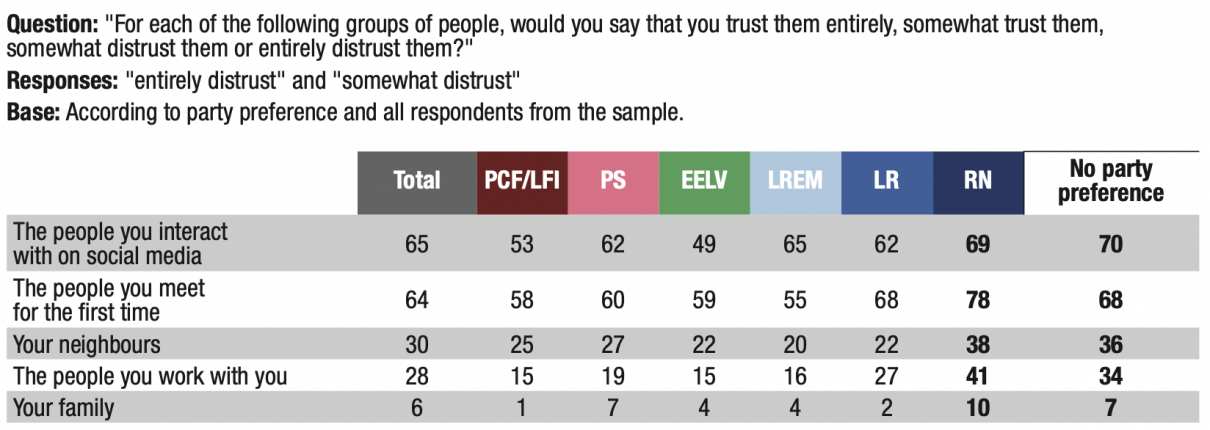
Copyright :
© Fondation pour l’innovation politique – October 2020
Women and young people seem to offer new reservoirs for electoral protest
The willingness to cast a protest vote is increasing among women voters…
In wave 1 (September 2019), 28% of women said they would vote for a RN candidate in the first round in 2022, compared to 34% of men, a difference of 6 points. In wave 2 (January 2020), the gap narrowed by 4 points: 30% of women and 32% of men were willing to vote for RN in the presidential election. During wave 3 (September 2020), this reduction in the gap between women and men was confirmed, but in a context of increased availability of the RN vote, both among women (31%) and men (34%). Conversely, wave 1 showed that the willingness to vote for LFI in the first round of the presidential election was more prevalent among women (22%) than men (18%). Here too, the gender gap narrowed, but in a context of a populist push, as wave 3 showed that 23% of women and 24% of men said they could vote for a LFI candidate. In the run-up to the first round of the presidential election, wave 3 confirms the greater willingness of women to abstain from voting (49%, compared to 40% for men) or to vote blank (54% compared to 44%). In the hypothesis of a second round opposing Emmanuel Macron and Marine Le Pen, the women’s vote remains marked by uncertainty. Fewer women than men consider voting for Marine Le Pen (22% vs. 27%), but also for Emmanuel Macron (30% vs. 34%). Above all, 17% of women say they do not yet know what they will do in 2022, 8 points higher than for men (9%).
In the event of a Macron/Le Pen second round, fewer women would vote for the latter

Copyright :
© Fondation pour l’innovation politique – October 2020
This rise in female Euroscepticism should be highlighted. In September 2020, only 1 in 2 women (50%) is in favour ofthe European Union and the fact that France is part of it (compared to 56% of men). In wave 1 (September 2019), 54%of women shared this opinion (compared to 56% of men). The gap between women and men is even greater when it comesto the euro: 48% of women say they are in favour of the European currency, compared to 59% of men, a difference of 11points. This Eurosceptic sentiment, however, does not necessarily translate into a willingness to leave the EuropeanUnion. In September 2020, 17% of women say they want to leave the European Union, a proportion stable in relation to our January 2020 data (17%) but higher than in September 2019 (15%). An increased sensitivity of the femaleelectorate to the Eurosceptic discourse could be a reserve for populist candidacies.
… and among younger voters
Another important resource for protest voting is the 18-24 year-olds. Our two previous waves (September 2019 andJanuary 2020) showed a youth attracted, more than their elders, to left-wing populist and revolutionary parties (LFI and LO/NPA) but less sensitive to the discourse of right-wing populisms. This attraction reached a peak in January 2020, ina context marked by major social unrest over the retirement reform. More than a third (36%) of 18-24 year-olds said they would be able to vote in the first round of the 2022 presidential election for a LFI candidate (12 points above the average, 24%) and 27% for an LO/NPA candidate (8 points above the average, 19%). In wave 2 (January 2020), 18-24 year-olds were only slightly less likely to vote for a RNcandidate (27%, versus 31% on average).
In wave 3 (September 2020), 35% of 18-24 year-old respondents said they could vote for a LFI candidate and 27% for anLO/NPA candidate. It is nonetheless towards the right that the willingness to vote populist increased in this age group: athird of 18-24 year-olds (33%) would vote for a RN candidate, 6 points more than in the second wave in January 2020(27%); more than a quarter (26%) would vote for a DLF candidate in the first round in 2022, 5 points more than in January2020 (21%).
In September 2020, more than half of 18-24 year-olds (54%) could abstain from voting, an increase of 9 points compared to January 2020 (45%). Concerning the blank vote, 60% of 18-24 year-olds responded that they could resort toit, the same result as in wave 2 (January 2020), but this represents 9 points more than the result (51%) recorded inwave 1 (September 2019).
To qualify the interpretation of these data, it should be noted that 66% of 18-24 year-olds believe that it is “voting is worthwhile because elections can make a difference”, 6 points above the average (60%), and up 3 points comparedto January 2020 (63%). In addition, the 18-24 year-old electorate remains open to the diversity of political offeringsin the run-up to the first round of the presidential election: 31% are willing to vote for a LR candidate (versus 36%on average), 35% for a PS candidate (versus 31%), 36% for a LREM candidate (versus 34%), but most importantly,half of them (52%) would be willing to vote for an EELV candidate, 10 points higher than the average (42%). In addition,15% of this electorate believe they could vote for each of these four parties, compared to 8% on average.
Lastly, when asked to indicate which of the two possibilities would be most important for them in a second round between avoiding the re-election of Emmanuel Macron and avoiding the election of Marine Le Pen, the majority of 18-24 year-olds (55%) respond that they want to avoid the election of Marine Le Pen. While this figure is in line with the average (53%), it is 5 points higher than in January 2020 (50%).
Evolution of the willingness to cast protest votes according to age between September 2019 and September 2020
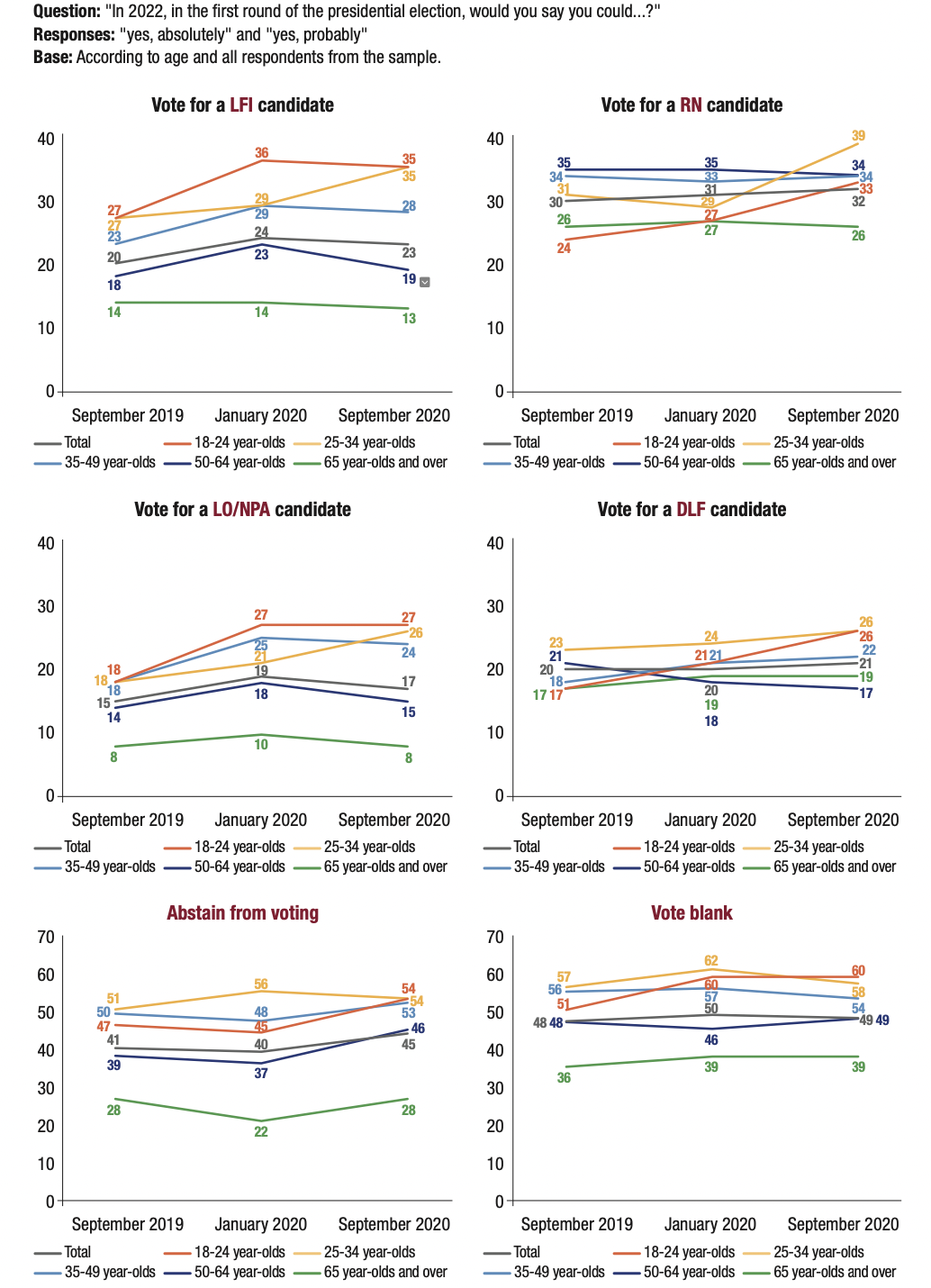
Copyright :
© Fondation pour l’innovation politique – October 2020
The progress of electoral protest does not spare the upper socio-professional category
See Brice Teinturier, “2nd tour présidentielle 2017 : sociologie des électorats et profil des abstentionnistes“,ipsos.com, 7 May 2017.
In the second round of the 2017 presidential election, the upper socio-professional category largely supported Emmanuel Macron, especially those with mid-level skilled professions, while blue-collar workers went for the Le Pen vote15. In September 2020, the situation seems less clear-cut, to the point of thinking that some of the upper socio-professional category, i.e. craftspeople, retailers, business managers, executives, those with higher intellectual professions and mid-level skilled professions, seem to be ready to cast protest votes in 2022.
* The “populist vote” option here groups together respondents who answered that they could vote for at least one of the four proposed populist or revolutionary left-wing parties (RN, LFI, DLF, LO/NPA).
The protest temptation from the upper socio-professional category
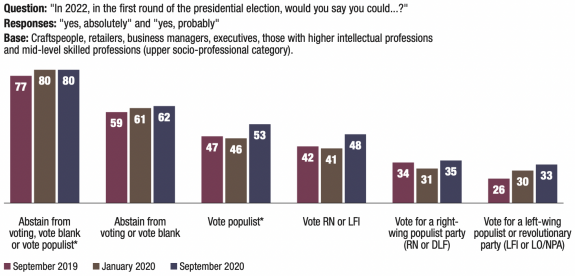
© Fondation pour l’innovation politique – October 2020
In one year, between wave 1 (September 2019) and wave 3 (September 2020), the proportion of those in the upper socio-professional category who declared they would vote for a LFI candidate in the first round of the presidential election increased from 22 to 29% (+7 points). To a lesser extent, those in the upper socio-professional category are also more likely to say they would vote for a RN candidate (from 28 to 30%). Over thesame period, the willingness of those in the upper socio-professional category to abstain from voting in the firstround of 2022 increased from 44 to 49%.
Perception of the worth of voting is declining among the upper socio-professional category

Copyright :
© Fondation pour l’innovation politique – October 2020
However, in the event of a second round between Emmanuel Macron and Marine Le Pen, this temptation among the upper socio-professional category to cast a protest vote remains relative, as our data from September 2020 show. In such a perspective, more than a third (34%) of them say they “will definitely” or are “very likely to” vote for the current President, 20% for the leader of the RN and 29% would abstain from voting or vote blank. These results are stable compared to wave 1 (September 2019). In addition, when asked to choose between the following two options, “avoid the election of Marine Le Pen” or “avoid the re-election of Emmanuel Macron” in the second round in 2022, those in the upper socio- professional category remain more numerous (58%) than the average (53%) in wanting to prevent Marine Le Pen’s potential election. Moreover, after a significant drop in January 2020 in a context marked by opposition to the retirement reform, satisfaction with Emmanuel Macron within this group has returned to the same level as it was twelve months ago: to the question “are you very satisfied, somewhat satisfied, somewhat dissatisfied or very dissatisfied with Emmanuel Macron’s action as President?”, 38% of those in the upper socio-professional category respond that they are satisfied (compared to 32% in January 2020).
Although those in the upper socio-professional category are the ones who judge the way in which the public authorities have reacted to the coronavirus most favourably (43% consider the management satisfactory, compared with 39% on average), a majority (55%) express their dissatisfaction on the contrary. Those in the upper socio-professional category (craftspeople,retailers, business managers and those with mid-level skilled professions) are strongly affected by the economic consequences of the health crisis. The evolution of their situation will therefore be decisive for the 2022 presidential election.
For those in the upper socio-professional category, security will also be a key issue. Indeed, while unemployment is cited most often among the three problems that the government should address as a priority (55%), the fight against criminal behaviour has taken on considerable importance, with a jump up 18 points between September 2019 and September 2020, from 31 to 49%.
Note: Those in the upper socio-professional category include craftspeople, retailers, business managers, executives, those with higher intellectual professions and mid-level skilled professions. Those in the lower socio-professional category include white-collar workers and blue-collar workers.
The French prioritise the fight against unemployment and the fight against criminal behaviour
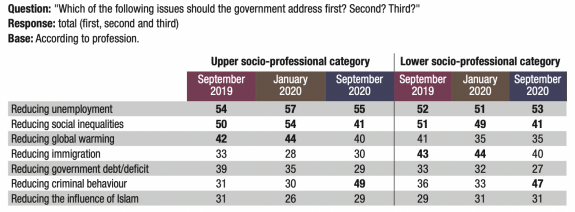
© Fondation pour l’innovation politique – October 2020
Fragile resistance to the populist surge
Coronavirus concerns will affect the presidential election
In September 2020, 59% of respondents felt that the coronavirus crisis had been mishandled by the government. Among them, a quarter (25%) even felt that the crisis had been “very poorly” managed. Party affiliation plays an important role in how the government’s actions during the pandemic were assessed. Among the voters close to LREM, only 10% consider that the crisis was poorly managed. This negative judgement rises to 54% among those close to PS and 58% among those close to LR. It is on the extreme sides of the political spectrum that disapproval is most widespread: 80% of those close to LFI and 78% of those close to the RN feel that the government mismanaged the health crisis. Respondents with no stated partisan preference are 64% to share this judgement.
Dissatisfaction with the management of the health crisis favours the protest vote
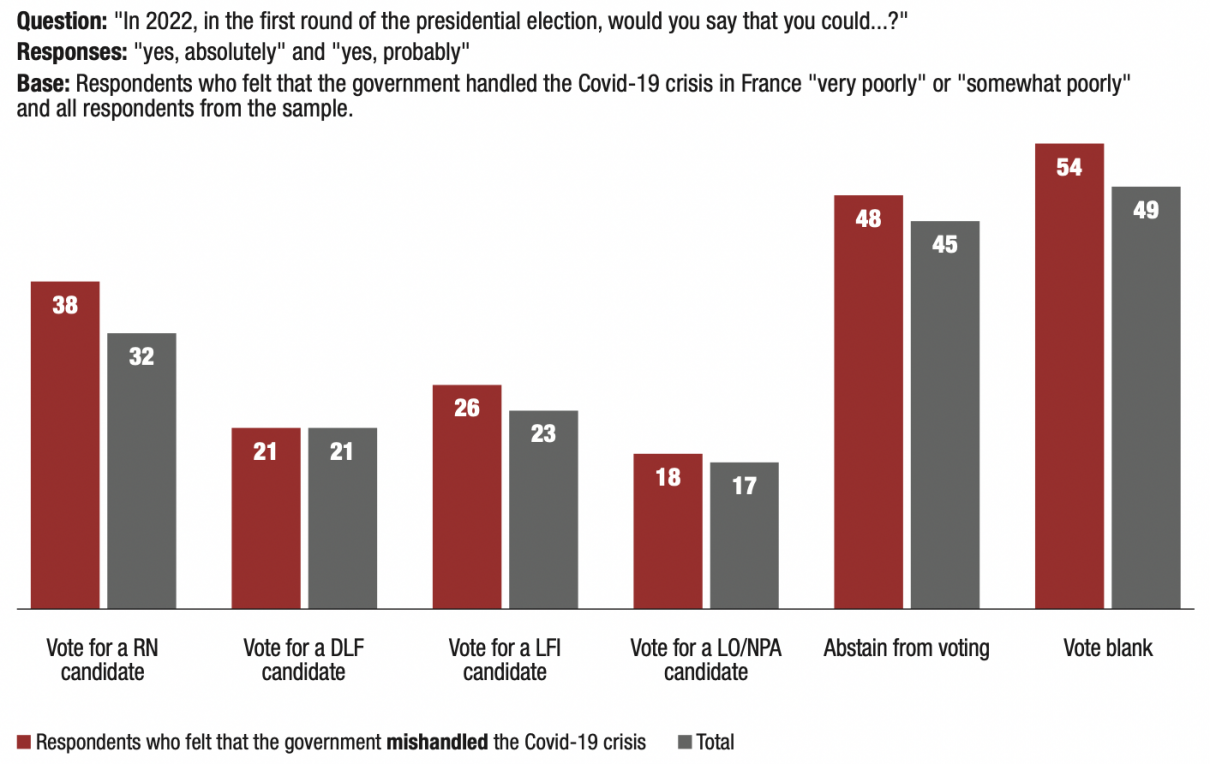
Copyright :
© Fondation pour l’innovation politique – October 2020
Marine Le Pen seems to be able to capture more votes than her competitors on both ends of the spectrum of anxiousness felt regarding the health crisis: 26% of people who say they are “very worried” about Covid-19 “will definitely” or “will most likely” vote for the leader of the RN in the first round, but the same is true (25%) for those who, on the other hand, say they are “not at all worried”.
Note: The totals do not add up to 100% as respondents were asked to comment on each candidate and not to choose from them.
In the first round, Marine Le Pen’s electoral potential is stronger both among those most and least worried about the virus

© Fondation pour l’innovation politique – October 2020
The evaluation of how the health crisis was managed will also determine the second round of 2022

© Fondation pour l’innovation politique – October 2020
Note: The totals do not add up to 100% due to non-responses, which are not included in this table.
The assessment of how the health crisis was managed will be a driving force of protest behaviour in 2022. In the event of a second round between the President and Marine Le Pen, a majority (55%) of respondents who believe that the government poorly managed the Covid-19 crisis would like to “avoid the re-election of Emmanuel Macron as President”, 15 points higher than the average of all respondents (40%). Among those who feel that the government mismanaged the crisis, 38% respond that above all else they want to “avoid the election of Marine Le Pen as President”, compared with 53% on average (7% did not respond).
Sense of mismanagement of the Covid-19 crisis feeds the vote against Emmanuel Macron
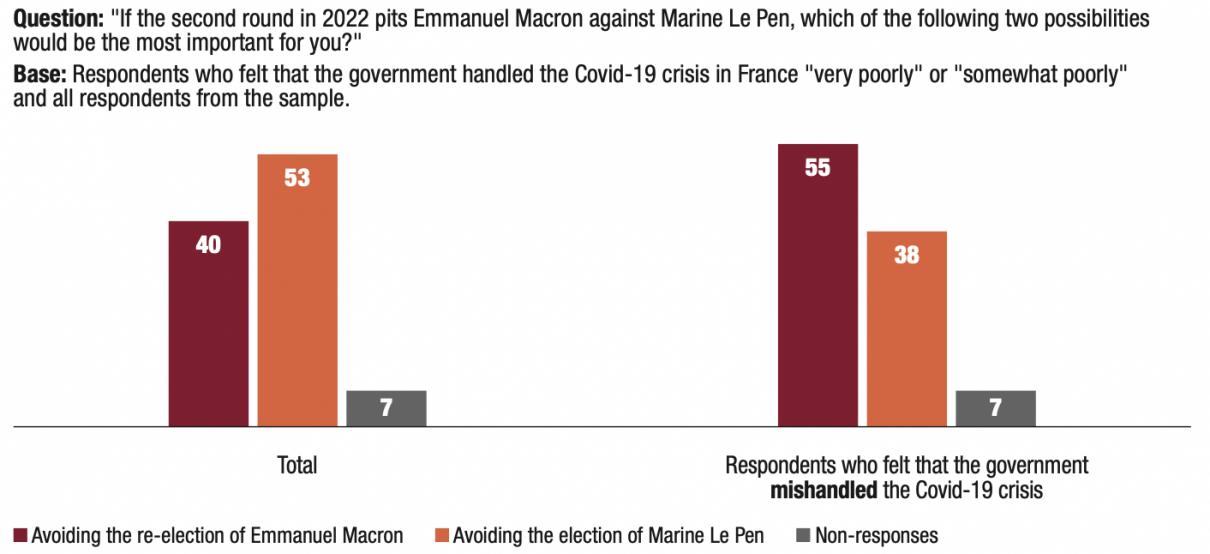
Copyright :
© Fondation pour l’innovation politique – October 2020
No party is credited with greater competence in managing this crisis
Despite the rather negative assessment of the government’s handling of the crisis, few voters believe that other parties would have done better. The highest score was 12%, in favour of the RN. A clear majority of respondents believe that both the PS (67%) and the LR (70%) would have done “neither better nor worse” in managing the crisis. Only 25% of respondents close to the PS believe that their party would have done better, and nearly three-quarters (72%) believe that it would have done “neither better nor worse”. LR supporters are more likely (39%) to believe that their party would have done better. It should be noted that the RN was highly credited among its supporters, since a majority of them (58%) believe that their party would have managed the health crisis better than the current government. The same confidence is found for LFI among the PCF/LFI’s supporters (60%). Nevertheless, LFI is considered, along with LO and NPA, to be one of the parties that would have handled the crisis the least well. One-third (34%) of respondents believe that LFI would have done “worse” than the current government if it had been in power (37% for LO and 36% for NPA).
Note: The totals do not add up to 100% due to non-responses, which are not included in this table.
According to public opinion, no party would have managed the health crisis better than the current government
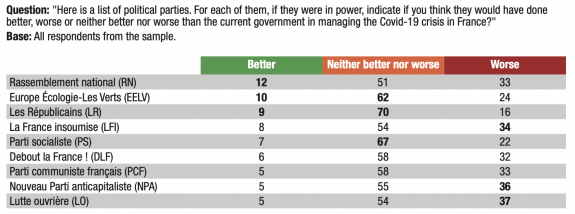
© Fondation pour l’innovation politique – October 2020
The “anti-vaxxers”: potential protest voters
One of the questions to come will be that of a vaccine against coronavirus. According to our data, 70% of respondents say they are ready to get the vaccine once it has been approved by the French health authorities, while 28% of respondents refuse to get it.
A majority (70%) would agree to get vaccinated against Covid-19, while a large minority (28%) say they would not
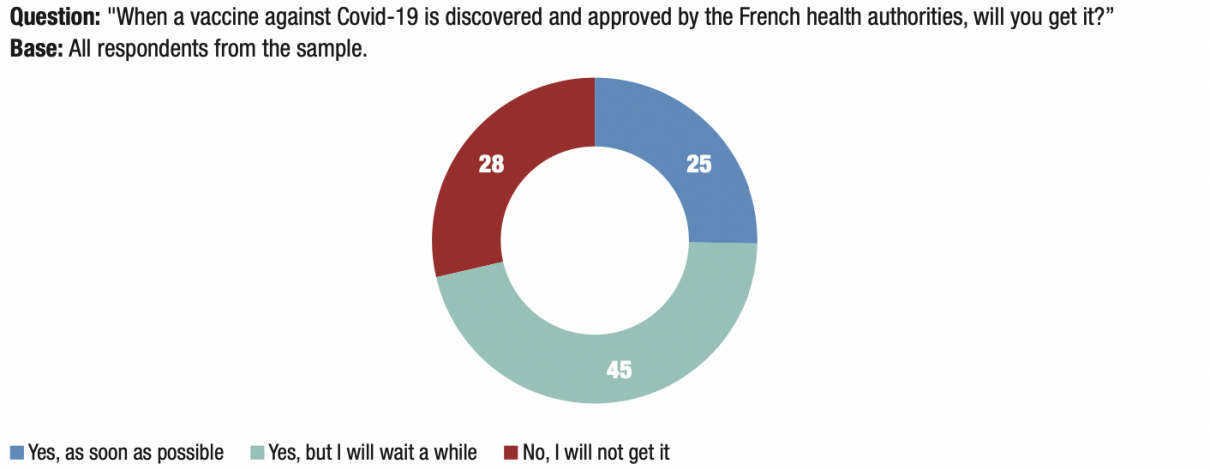
Copyright :
© Fondation pour l’innovation politique – October 2020
See Farid Gueham, Le Fact-Checking : une réponse à la crise de l’information et de la démocratie, Fondation pour l’innovation politique, July 2017.
The profile of those who claim to refuse to get vaccinated, sometimes referred to as “anti-vaxxers”, reveals a group that seems to be breaking away from the democratic system: 52% of “anti-vaxxers” find that “voting is pointless because politicians do not care about the will of the people”, just as 60% of people who will not get vaccinated believe that the best political system in France would be one wherein “citizens decide what is best for the country, rather than the government”.
Opposition to vaccination is strongly affected by the way voters inform themselves. Nearly half (46%) of those who get their information from new forms of media (social networks, blogs and forums, YouTube) say they will not get vaccinated, compared to 26% of those who get their information from traditional media (television, radio, print or online newspapers). We are aware of the increased permeability of content on the Internet to fake news16 and conspiracy theories, which are particularly prolific when it comes to vaccination.
Politically, “anti-vaxxers” are to be found on both extremes of the political spectrum and also among citizens detached from electoral life: 32% of respondents who voted for Jean-Luc Mélenchon in the first round in 2017, 33% of those who abstained from voting or voted blank and 37% of those who voted for Marine Le Pen say they will not get vaccinated.
Memo for the reader: among those who say they would not get vaccinated against Covid-19, 32% do not trust mayors, compared to 22% for all respondents from the sample.
“Anti-vaxxers”’ distrust in institutions is stronger than that of French people as a whole
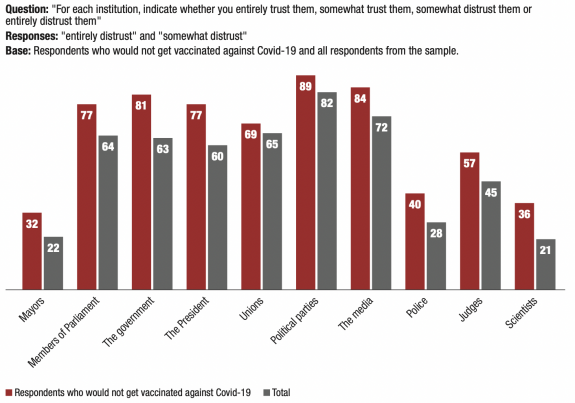
© Fondation pour l’innovation politique – October 2020
Looking ahead to 2022, “anti-vaxxers” have a significantly above average potential for electoral protest. In the first round, 87% could opt for at least one of the selected protest behaviours, compared with 79% on average.
This potential is particularly expressed through a willingness to vote for a right-wing populist party (44% could vote for the RN and/or DLF, compared to 38% on average).
* The “populist vote” option here groups together respondents who answered that they could vote for at least one of the four proposed populist or revolutionary left-wing parties (RN, LFI, DLF, LO/NPA).
“Anti-vaxxers” are more willing to cast protest votes
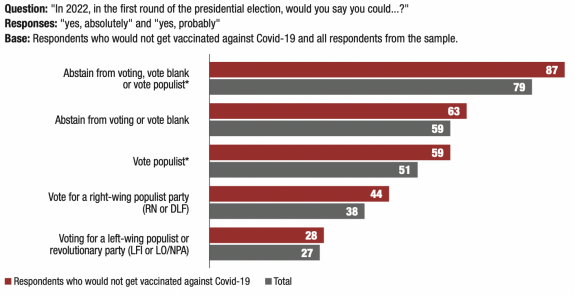
© Fondation pour l’innovation politique – October 2020
The profile of “anti-vaxxers”
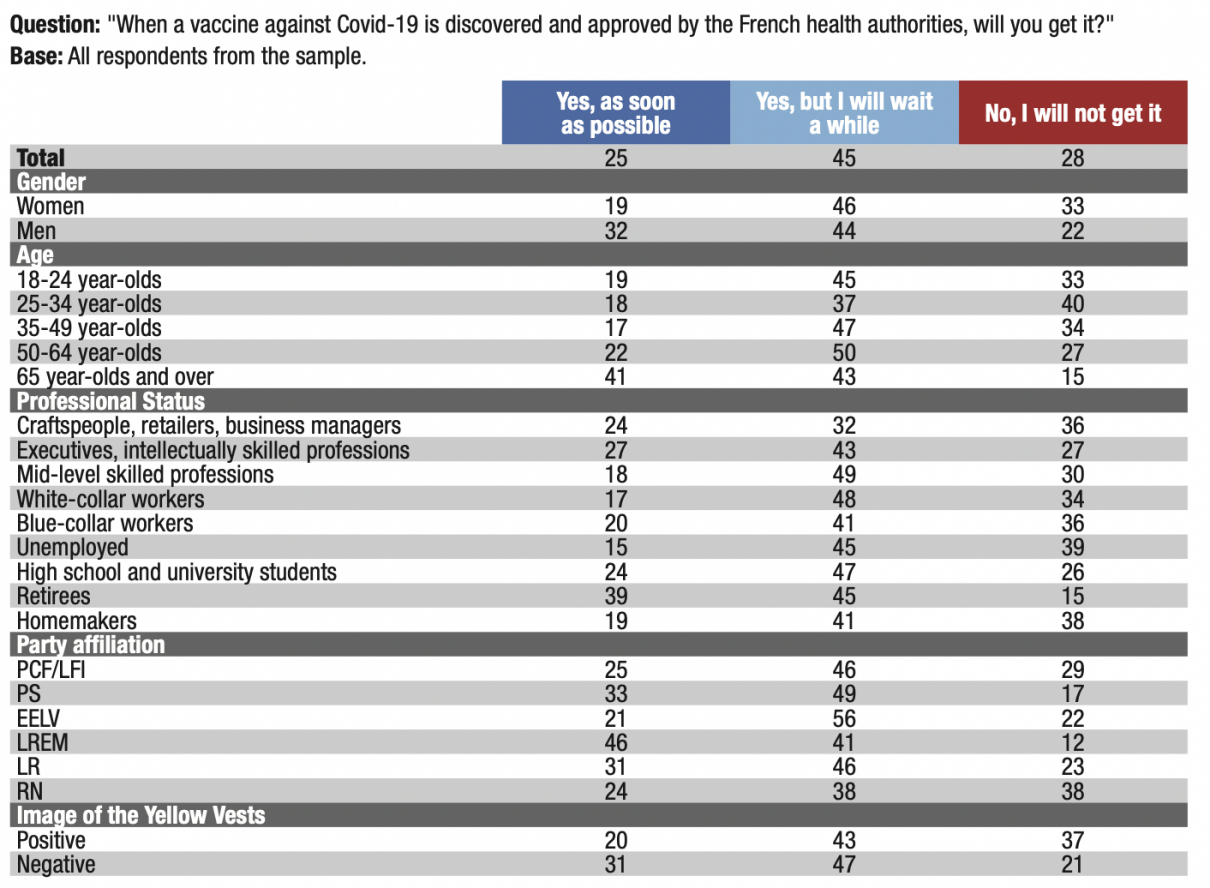
Copyright :
© Fondation pour l’innovation politique – October 2020
Note: The totals do not add up to 100% due to non-responses, which are not included in this table
Our indicator makes it possible to measure the change in electoral behaviour envisaged by voters claiming to be close to the PS or LR. For the first round of the 2022 presidential election, these electorates seem unpredictable, with preferences varying between abstention from voting, indecision, the populist temptation and support for the current majority. Thus, between January and September 2020 (waves 2 and 3), the propensity to abstain from voting increasedby 8 points (from 33 to 41%) among PS supporters and by 10 points (from 26 to 36%) among LR supporters.
Moreover, these electorates remain open to populist voting: 29% of PS supporters could vote for a LFI candidateand 40% of those close to LR could vote for a RN candidate.
These results remain partly due to the fact that in September 2020 there is not a clearly declared figure to representthe right, LR, or the left, PS, yet. However, almost all of those close to the PS (93%) and LR (97%) say they are prepared to vote for a candidate of their party in the first round in 2022.
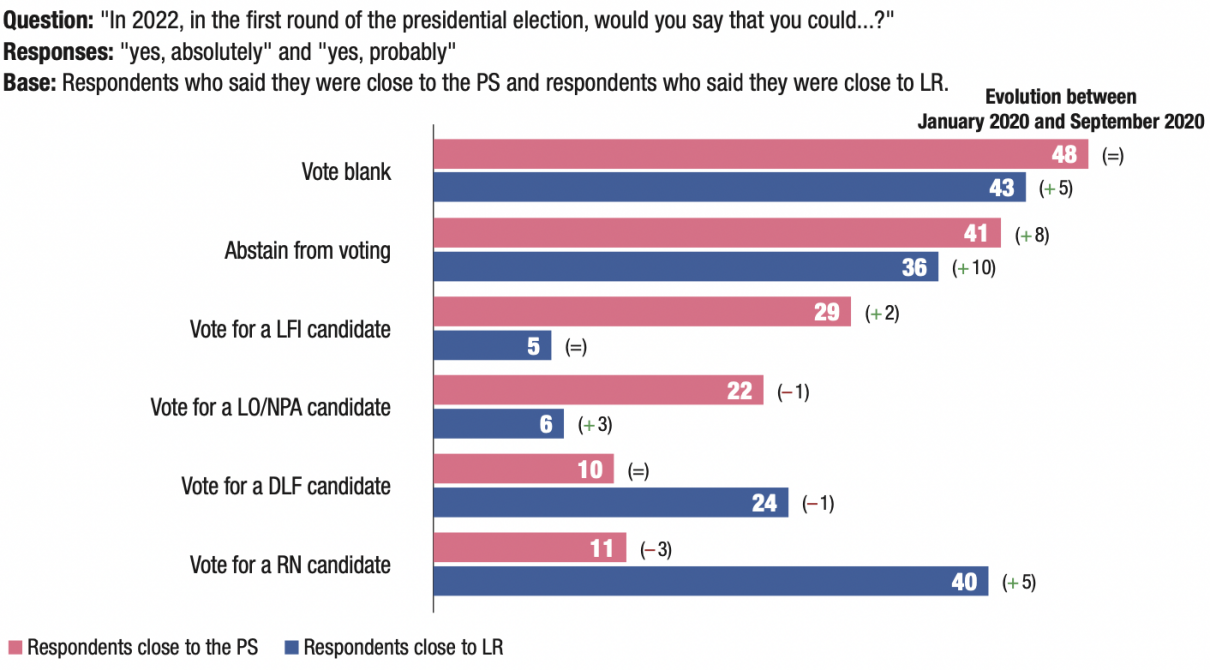
Copyright :
© Fondation pour l’innovation politique – October 2020
Within the framework of a second round which would oppose Emmanuel Macron to Marine Le Pen, significantevolutions appear between waves 2 (January 2020) and 3 (September 2020). Voters close to the PS and LR are morenumerous to say they “will definitely” or are “very likely to” vote for Emmanuel Macron: up 13 points for those close to thePS (from 36 to 49%) and up 11 points for LR supporters (from 29 to 40%). This appears to be a reversal of those who wereconsidering abstaining from voting or voting blank and a large proportion of voters who previously said they did not yet know who they would vote for: among PS supporters, abstention from voting and blank voting increased from 36 to 30%and indecision from 16 to 10%; among those close to LR, abstention from voting and blank voting increased from 29to 23% and indecision from 16 to 14%. It can be hypothesised that this movement is due, at least in part, to a morefavourable perception of crisis management by the government: 46% of PS supporters and 42% of LR supporters consider that the public authorities managed the health crisis well, compared with 39% on average.However, as we can see, this positive judgement remains fragile and its future is uncertain. Wave 3 allows us to see that these two electorates are also more satisfied with Emmanuel Macron’s action as President (39% among PSsupporters and 41% for LR) than the average French person (35%); the situation has clearly improved compared to wave2 of January 2020, when 24% of PS supporters and 33% of LR supporters declared that they were satisfied with thePresident (compared to 29% on average). Between waves 2 and 3, the hypothesis of a second round opposingEmmanuel Macron to Marine Le Pen became more favourable to Emmanuel Macron: 72% of PS supporters (compared to 64% in January 2020) and 59% of those close to LR (compared to 55% in January 2020) prioritise “avoiding the election of Marine Le Pen” (rather than “avoiding the re-election of Emmanuel Macron”).
On the other hand, between waves 1 (September 2019) and 3 (September 2020), we observe a process of solidification of a fraction of the electorate claiming that they “will definitely” or are “very likely to” vote for Marine Le Pen in a second round opposing her to Emmanuel Macron: among respondents close to LR, as this proportion rose from 21 to 23%, after a peak (26%) inJanuary 2020. Among PS supporters, over the same period, the proportion rose from 8 to 11%.
The proportion of PS supporters planning to vote for Emmanuel Macron in 2022 is on the rise
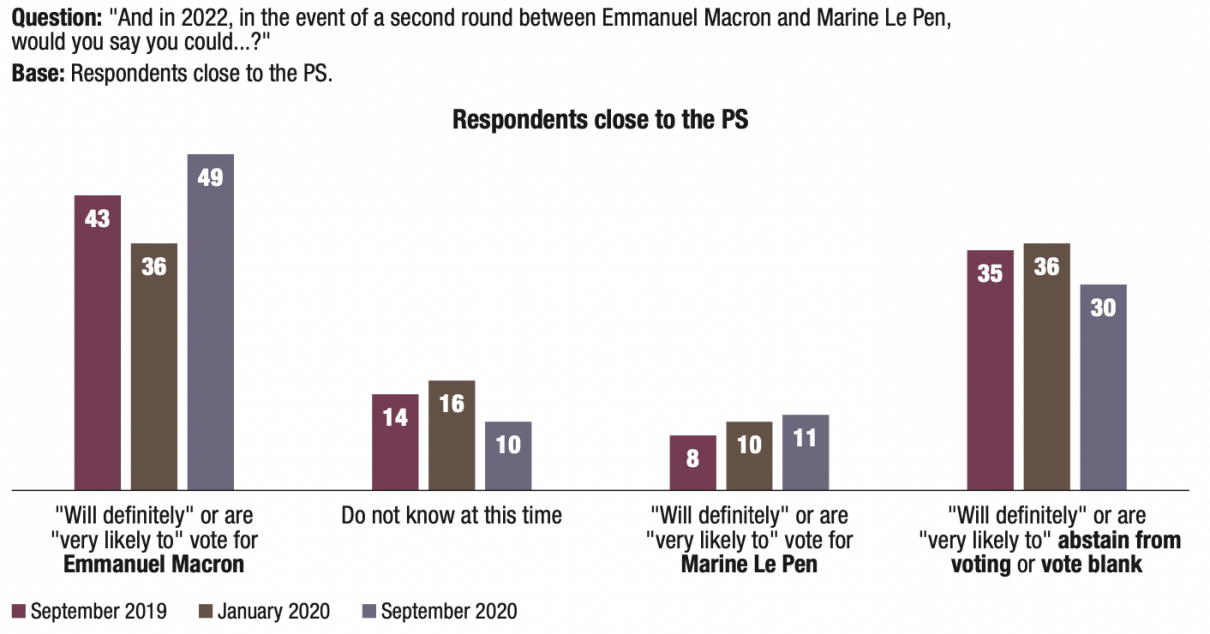
Copyright :
© Fondation pour l’innovation politique – October 2020
Note: The totals do not add up to 100% due to non-responses, which are not included in this graph.
The proportion of LR supporters planning to vote for Emmanuel Macron in 2022 is also increasing
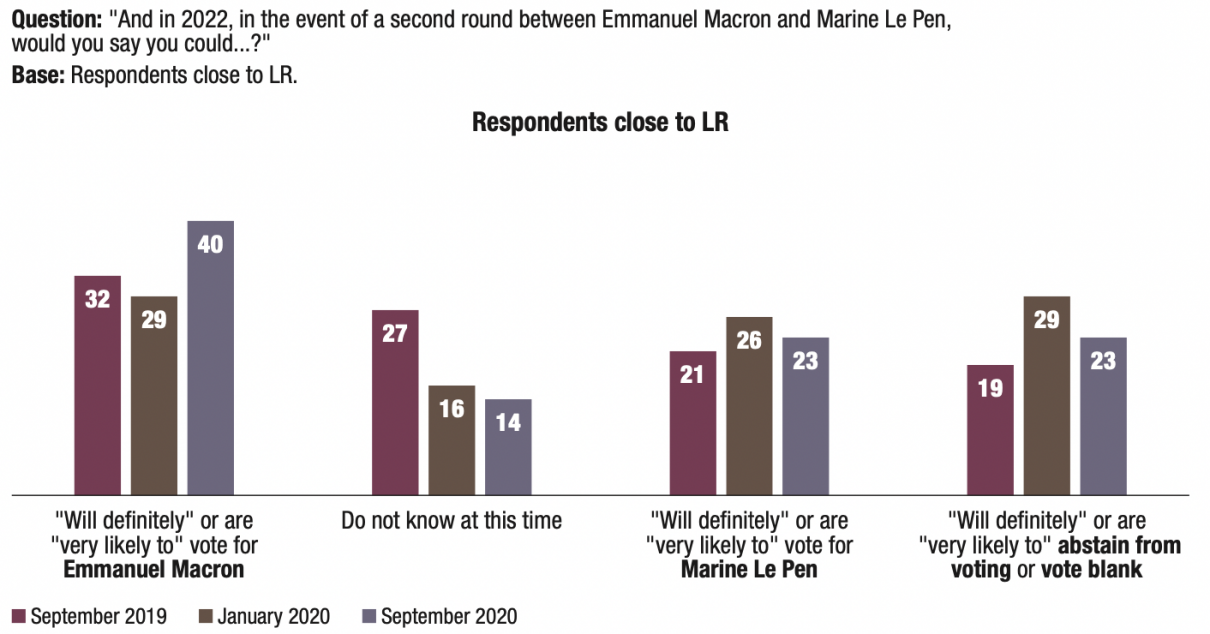
Copyright :
© Fondation pour l’innovation politique – October 2020
Note: The totals do not add up to 100% due to non-responses, which are not included in this graph.
Wave 3 (September 2020) confirms voters’ attachment to Europe and the euro: 80% want France to remain in the European Union.
A stable minority (17%, compared to 18% in January 2020) of respondents would like France to leave the European Union.
Most French people want to keep the euro
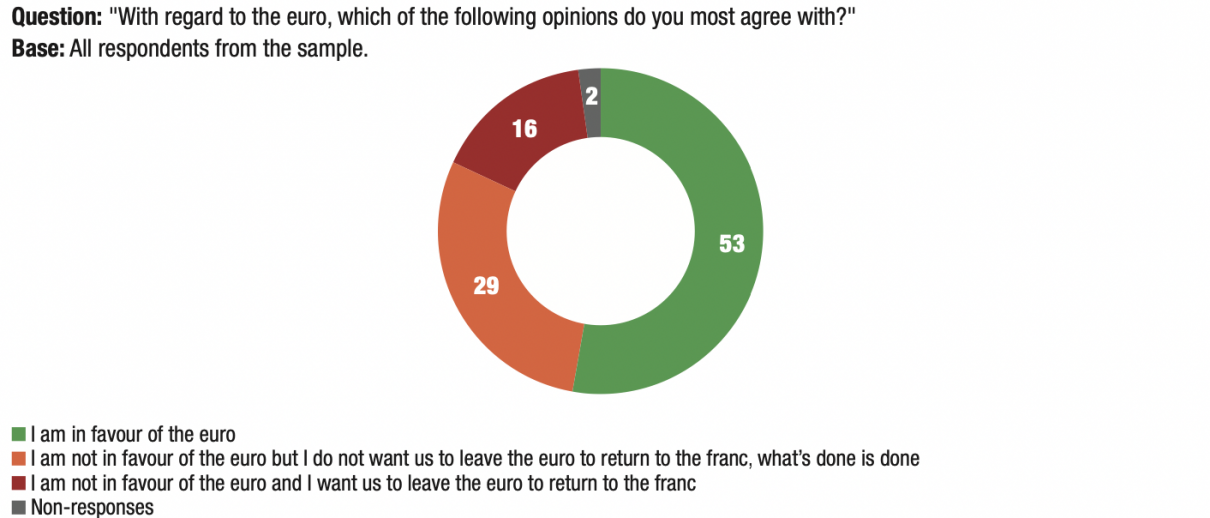
Copyright :
© Fondation pour l’innovation politique – October 2020
This attachment can be seen in the electorates of Marine Le Pen and Jean-Luc Mélenchon. Populisms thus come up againstthe Europeanisation of their own electorates, which constrains them in the expression of their Euroscepticism. Populistleaders are all the less capable of proposing a convincing discourse as the European Union seems to be gaining strength inpublic opinion.
Two-thirds (64%) of Marine Le Pen’s voters in the first round of 2017 do not wish to abandon the euro. For Jean- LucMélenchon, the evolution is significant: there is an increase of 8 points (from 79% in January 2020 to 87% in September2020) among these voters who wish to keep the euro, and a decrease of 7 points (from 19 to 12%) among those who say theyare in favour of a return to the franc.
Marine Le Pen voters want to keep the euro
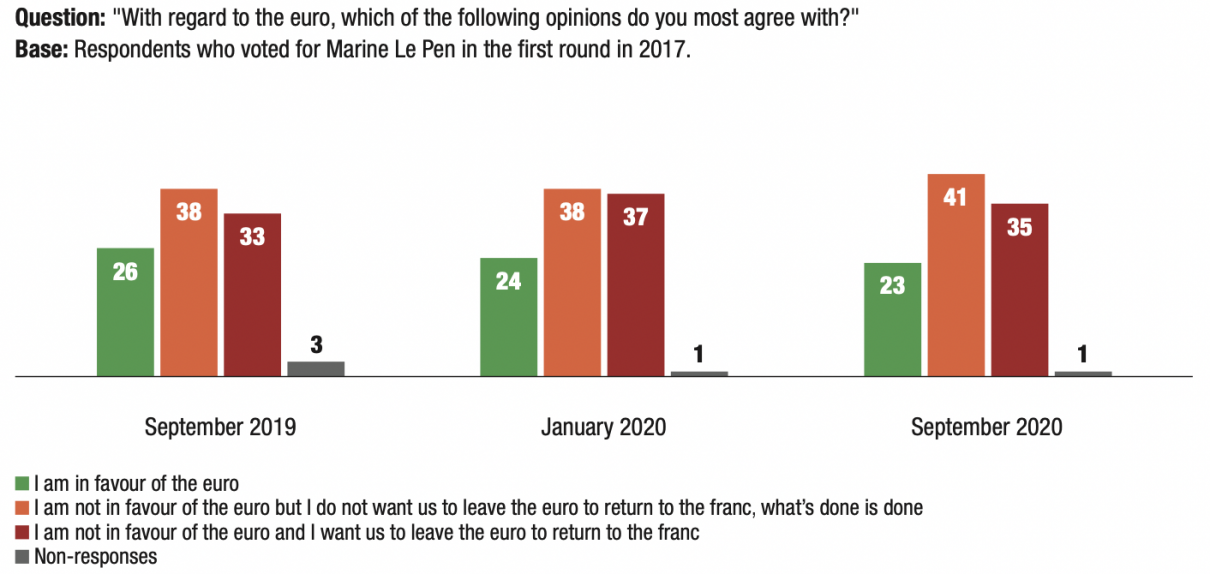
Copyright :
© Fondation pour l’innovation politique – October 2020
… Jean-Luc Mélenchon’s voters also want to keep the euro
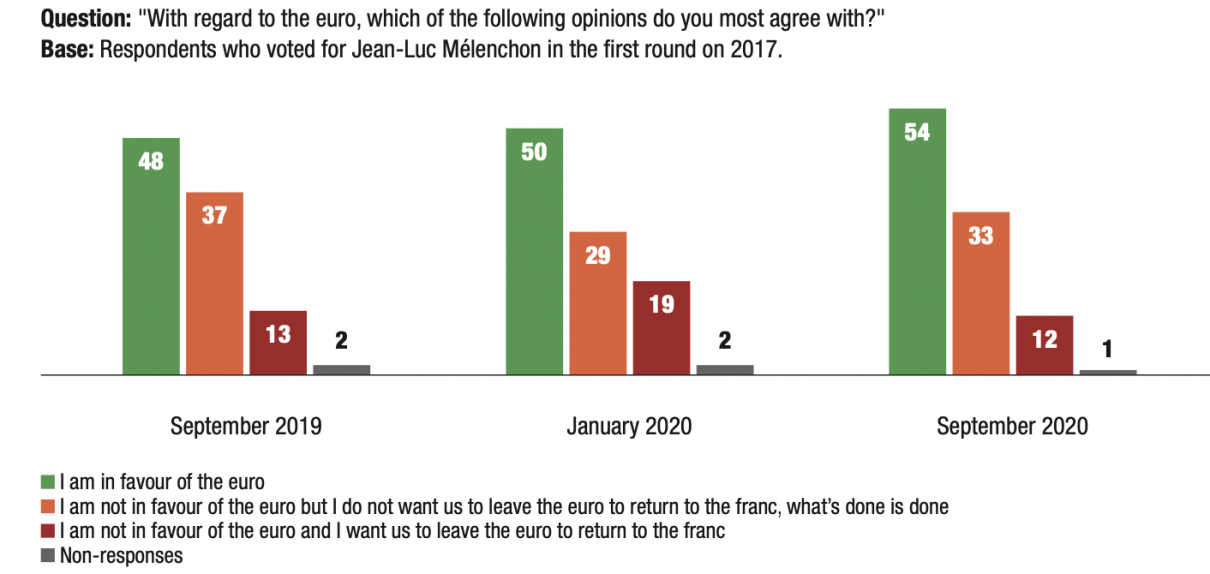
Copyright :
© Fondation pour l’innovation politique – October 2020
Memo for the reader: 86% of those close to LREM are in favour of the European Union and the fact that France is a part of it.
* Respondents were asked about the trust they have in the following figures and institutions: mayors, members ofParliament, the government (ministers and the Prime Minister), the President, unions, political parties and the media(not including the police, judges and scientists).
The profile of those in favour of the European Union
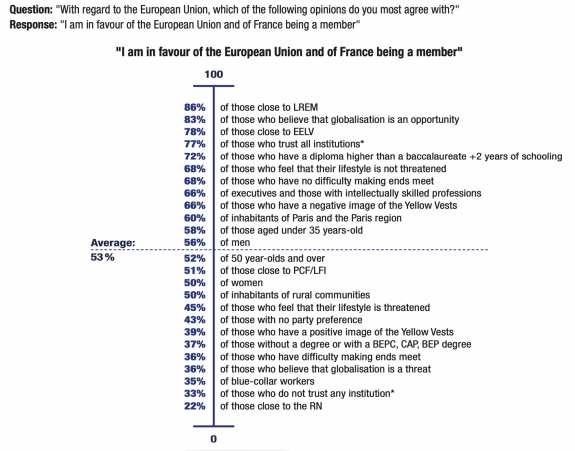
© Fondation pour l’innovation politique – October 2020
The two populist leaders, like the rest of the political class, incite a feeling of weariness among voters who wouldrather see new candidates emerge.
Concerning Jean-Luc Mélenchon, 40% of the interviewees want LFI to put another candidate forward for the 2022 presidential election. This is less than in January 2020, when 45% of respondents wanted another leader for LFI, eventhough the context of the Yellow Vests and the retirement reform seemed likely to be favourable to the populist andradical left. However, this recovery does not allow Jean-Luc Mélenchon to secure his position as leader of the party, since he returned to a level close to wave 1 (41% in September 2019). The desire for a change of candidate is more widespread among those who voted for Jean-Luc Mélenchon in the first round of the 2017 presidential election: a clear majority (58%) of them want the party to put another candidate forward in 2022, 5 points less than in January 2020 (63%), but 1 point higher than in September 2019 (57%).
The attrition of Marine Le Pen, understood as the demand for a new candidate, is less pronounced across the electorate as a whole (35%) than in her electorate from 2017: 44%, up 5 points from wave 2 in January 2020(39%). The figures are even higher among those who voted for the RN in the 2019 European elections: almost halfof them (47%) want the party to nominate another candidate other Marine Le Pen in our third wave, 7 points higher(40%) than in January 2020.
In their respective electorates, Marine Le Pen’s attritionis less marked than that of Jean-Luc Mélenchon, thoughit is increasing
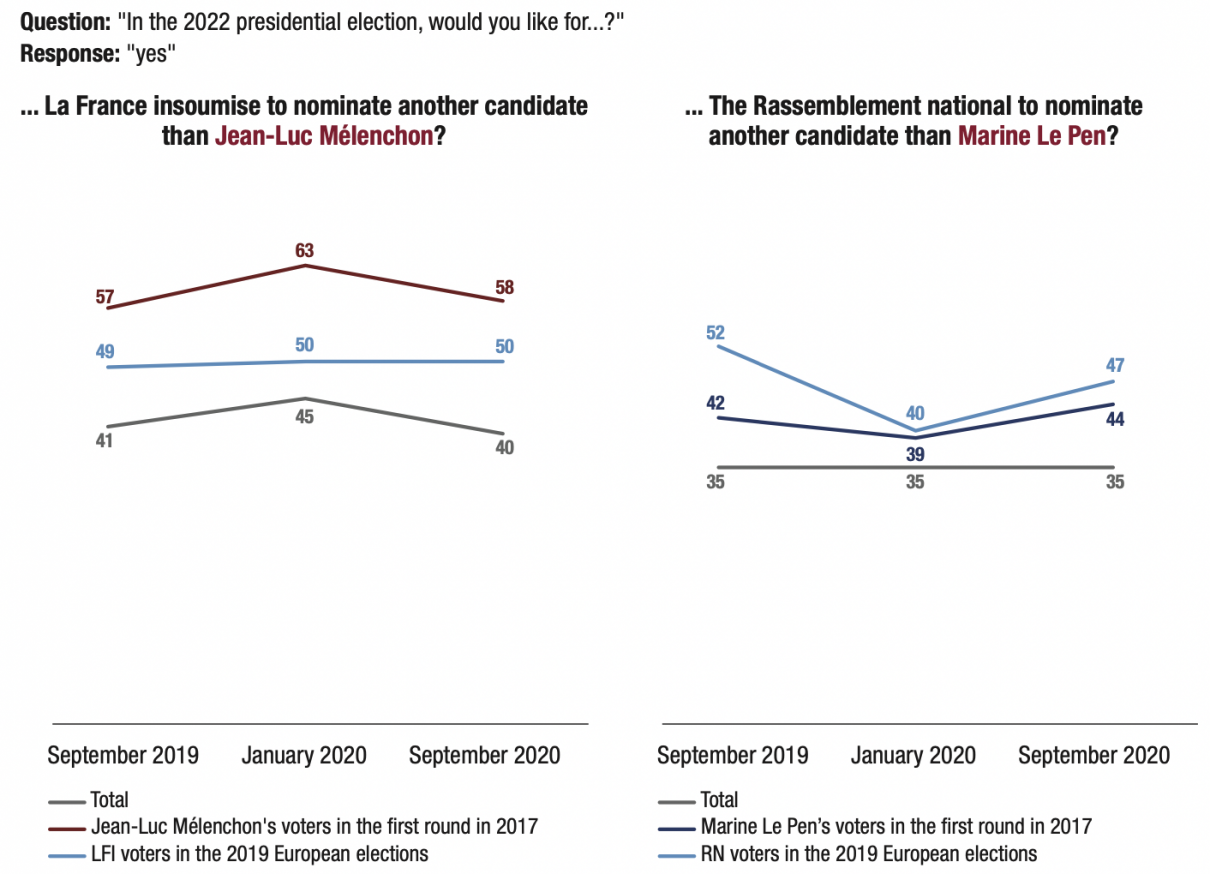
Copyright :
© Fondation pour l’innovation politique – October 2020
The survey’s questionnaire
DEMOGRAPHIC INFORMATION
• Gender
• Age
• Region of residency
• Size of town
• Education level
• Occupation
• Status (working or not working)
• Monthly household income
• Number of people living in home
• Party affiliation
• Level of interest in politics
• Vote in the 2012 Presidential election (first and second round)
• Vote in the 2017 Presidential election (first and second round)
• Vote in the 26 May 2019 European elections
• Self-positioning on a left/right political scale
• Are you very satisfied, somewhat satisfied, somewhat dissatisfied or very dissatisfied with Emmanuel Macron’s actions as President?
– Very satisfied
– Somewhat satisfied
– Somewhat dissatisfied
– Very dissatisfied
• How easily do you manage to make ends meet?
• Very easily
• Quite easily
• I get by
• With some difficulty
• With great difficulty
• I cannot manage
• Overall, would you say that you are satisfied with the life you lead?
– Yes, absolutely
– Yes, somewhat
– No, not really
– No, absolutely not
• Can you tell me what your religion is, if you have one?
– Catholic
– Protestant
– Muslim
– Jewish
– Other religion
– No religion
– Do not wish to respond
• In general, your main sources of information are? (First, second)
– The major television channels (TF1, France 2, France 3, France 5, M6, Canal+, ARTE)
– YouTube
– 24-hour news channels (CNews, LCI, BFM TV, France info TV)
– Newspapers (print or online)
– The radio
– Blogs or forums on the Internet
– Social media (Facebook, Twitter, Instagram, TikTok, etc.)
– Discussions with those around you (with family, neighbours, friends, at work)
1. Which of the following statements is the closest to your personal opinion?
• Globalisation is an opportunity
• Globalisation is a threat
2. Generally speaking, do you feel that your standard of living has gotten better or worse over the past few years?
• It has gotten better
• It has remained the same
• It has gotten worse
3. Would you say that your lifestyle or the way of life is now threatened?
• Very threatened
• Threatened
• Not very threatened
• Not at all threatened
4. Since you have had the right to vote, have you ever voted at least once for the following parties or any of their candidates…?
Responses:
– “Yes”
– “No”
• The Front national/Rassemblement national
• The Front de gauche/La France insoumise
• Lutte ouvrière/Nouveau Parti anticapitaliste (NPA)
• Debout la France !
5. And since you have had the right to vote…?
Responses:
– “Yes”
– “No”
• You have abstained from voting
• You have voted blank
6. With regard to the European Union, which of the following opinions do you most agree with?
• I am in favour of the European Union and of France being a member.
• I am not in favour of the European Union, but I do not want France to exit it, what’s done is done.
• I am not in favour of the European Union and I want France to exit it.
7. With regard to the euro, which of the following opinions do you most agree with?
• I am in favour of the euro.
• I am not in favour of the euro, but I do not want us to leave the euro and return to the franc, what’s done is done.
• I am not in favour of the euro and I want us to leave the euro and return to the franc.
8. Which of the following opinions best aligns with your views?
• Voting is worthwhile because elections can make a difference
• Voting is pointless because politicians do not care about the will of the people
9. In 2022, in the first round of the presidential election, would you say that…?
Responses:
– Yes, absolutely
– Yes, somewhat
– No, not really
– No, not at all
• You could vote for a candidate from the Rassemblement national (RN)
• You could vote for a candidate from Debout la France ! (DLF)
• You could vote for a candidate from La France insoumise (LFI)
• You could vote for a candidate from the Lutte ouvrière (LO)/Nouveau Parti anticapitaliste (NPA)
• You could abstain from voting
• You could vote blank
9 (cont.). In 2022, in the first round of the presidential election, would you say that…?
Responses:
– Yes, absolutely
– Yes, somewhat
– No, not really
– No, not at all
• You could vote for a candidate from Les Républicains (LR)
• You could vote for a candidate from La République en marche (LREM)
• You could vote for a candidate from the Parti socialiste (PS)
• You could vote for a candidate from Europe Écologie-Les Verts (EELV)
• You could abstain from voting
• You could vote blank
10. In 2022, in the first round of the presidential election, for each of the following potential candidates, would you say that…?
Assessed candidates: Marine Le Pen / Jean-Luc Mélenchon / Emmanuel Macron
• You will definitely vote for him/her
• You will most likely vote for him/her
• You might vote for him/her
• You are unlikely to vote for him/her
• You will definitely not vote for him/her
11. And in 2022’s presidential election, in the event of a second round between Emmanuel Macron and Marine Le Pen, would you say that…?
• You will definitely vote for Marine Le Pen
• It is very likely that you will vote for Marine Le Pen.
• You will definitely vote for Emmanuel Macron
• It is very likely that you will vote for Emmanuel Macron
• You will definitely abstain from voting
• It is very likely that you will abstain from voting
• You will definitely vote blank
• It is very likely that you will vote blank
• Right now you do not know what you will do
12. If the second round in 2022 pits Emmanuel Macron against Marine Le Pen, which of the following two possibilities would be the most important for you?
• Avoiding the re-election of Emmanuel Macron as President
• Avoiding the election of Marine Le Pen as President
13. In the 2022 presidential election, do you hope that…
Responses:
– “Yes”
– “No”
• La France insoumise nominates another candidate than Jean-Luc Mélenchon
• The Rassemblement national nominates another candidate than Marine Le Pen
14. In your opinion, did the government handle the Covid-19 crisis in France very well, somewhat well, somewhat poorly or very poorly?
• Very well
• Somewhat well
• Somewhat poorly
• Very poorly
15. Regarding Covid-19, would you say that you are…?
• Very worried
• Somewhat worried
• Not very worried
• Not at all worried
16. Here is a list of political parties. For each of them, if they were in power, indicate if you think they would have done better, worse or neither better nor worse than the current government in managing the Covid-19 crisis in France?
Responses:
– Better
– Neither better nor worse
– Worse
• Nouveau Parti anticapitaliste (NPA)
• Lutte ouvrière (LO)
• Parti socialiste (PS)
• Parti communiste français (PCF)
• La France insoumise (LFI)
• Europe Écologie-Les Verts (EELV)
• Debout la France ! (DLF)
• Les Républicains (LR)
• Le Rassemblement national (RN)
17. When a vaccine against Covid-19 is discovered and approved by the French health authorities, will you get it?
• Yes, as soon as possible
• Yes, but I will wait a while
• No, I will not get it
18. We have heard a lot about the Yellow Vest movement. Would you say you have an image of the Yellow Vests that is…?
• Very positive
• Somewhat positive
• Somewhat negative
• Very negative
19. Which of the following issues should the government address first? Second? Third?
• Reducing unemployment
• Reducing the government debt/deficit
• Reducing immigration
• Reducing the influence of Islam
• Reducing social inequalities
• Reducing global warming
• Reducing criminal behaviour
20. Which of the following opinions best aligns with your views?
• Most immigrants do not share France’s values and this causes problems of cohabitation
• Most immigrants share France’s values and this allows for cultural enrichment
21. And which of the following opinions best aligns with your views?
• For France, economically speaking, immigrants are a disadvantage because their integration is expensive
• For France, economically speaking, immigrants are an advantage because their contributions generate wealth
22. Among the following three political systems, which one do you think is most needed in France at the moment? First? Second?
• A strong, elected leader, who would decide alone without worrying about what Parliament or the media say
• Having a democratic political system with an elected Parliament that controls the government
• Having citizens decide what is best for the country, rather than the government
23. For each of the following institutions, indicate whether you entirely trust them, somewhat trust them, somewhat distrust them or entirely distrust them
Responses:
– Entirely trust them
– Somewhat trust them
– Somewhat distrust them
– Entirely distrust them
• Mayors
• Members of Parliament
• Political parties
• The President
• Police
• The government
• The media
• Unions
• Judges
• Scientists
24. In general, you would say that…
• You can trust most people
• You can never be too careful when dealing with others
25. For each of the following groups of people, would you say that you entirely trust them, somewhat trust them, somewhat distrust them or entirely distrust them
Responses:
– Entirely trust them
– Somewhat trust them
– Somewhat distrust them
– Entirely distrust them
• Your family
• Your neighbours
• The people you work with
• The people you meet for the first time
• The people you interact with on social media
26. Do you discuss how things are going in the country with…?
Responses:
• Often
• From time to time
• Rarely
• Never
• Your family
• Your co-workers
• The people you meet on social media
• Your neighbours
• Your friends
27. In general, do you have the impression that the people you meet on social media share your opinion on the way things are going in France?
Responses:
• Yes, absolutely
• Yes, somewhat
• No, not really
• No, absolutely not
• Your family
• Your co-workers
• The people you meet on social media
• Your neighbours
• Your friends
28. In your opinion, is French society increasingly violent, as violent as in the past, or less and less violent?
• Increasingly violent
• As violent as in the past
• Less and less violent
29. Which of the following statements is the closest to your personal opinion?
• The media talk too much about violence in our society, they should talk about it less
• The media talk neither too much nor not enough about violence in our society
• The media do not talk enough about violence in our society, they should talk about it more
30. In your opinion, in France, to ensure security, would you say that the police…?
• Has too many resources
• Has enough resources
• Does not have enough resources
For those who answered “does not have enough resources”:
Say whether you strongly agree, somewhat agree, somewhat disagree, strongly disagree with the following statements:
Responses:
– Strongly agree
– Somewhat agree
– Somewhat disagree
– Strongly disagree
• The police do not have enough resources, they need to be given more
• The police do not have enough resources, you should have the right to own a gun in your home

